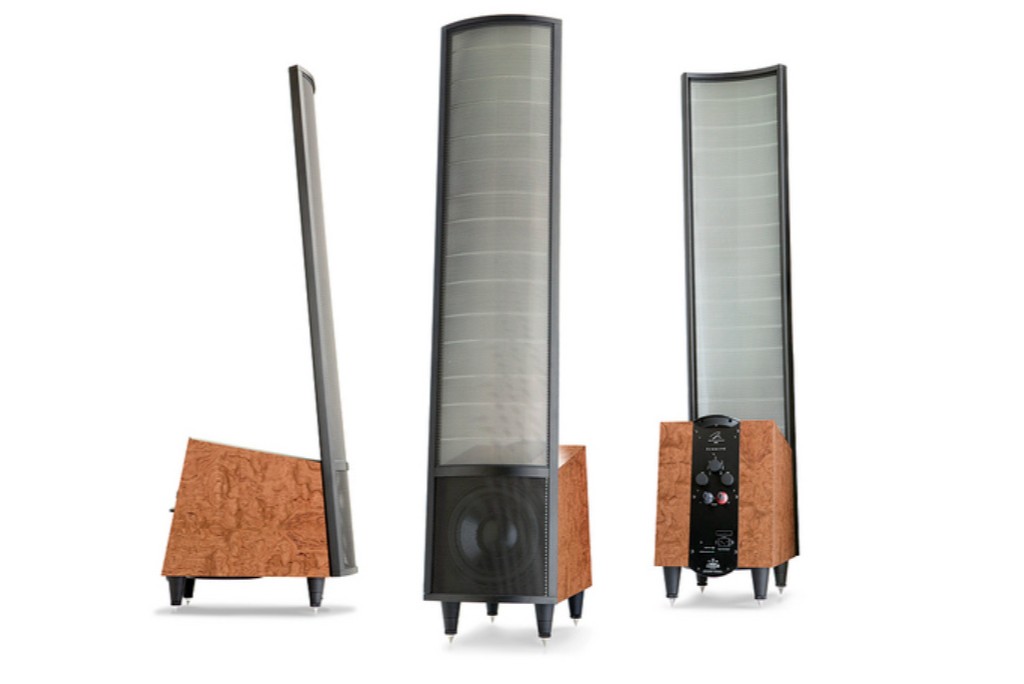Hi-Fi Hall of Fame
Technology Inductee
Electrostatic Loudspeaker
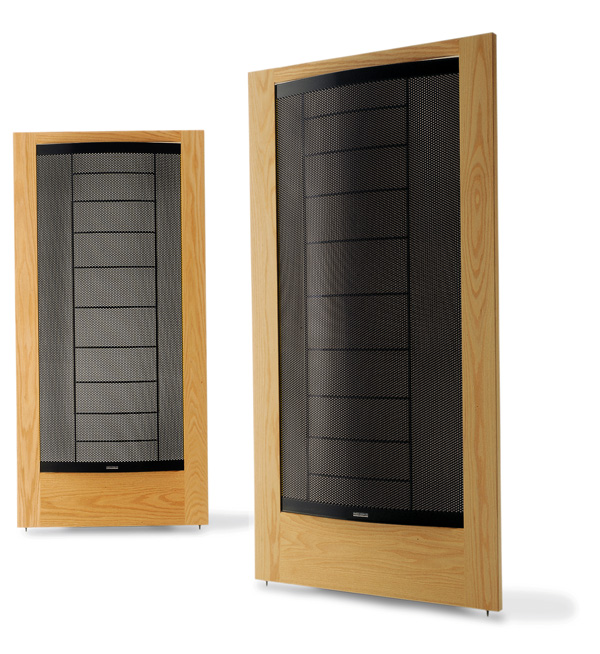
Introduction
Our next inductee in this category is Electrostatic Loudspeaker (ESL) technology. Electrostatic speakers and headphones are rather exotic and rare, and it’s possible that you have never heard nor even seen one!
Nonetheless, electrostatic loudspeaker technology has been a part of the Hi-Fi ecosystem for many years, and is an interesting part of Hi-Fi history, so let’s see why it belongs in the Hall of Fame.
Electrostatic Loudspeaker (ESL) Technology
Conventional “dynamic” loudspeakers employ a permanent magnet, voice coil, and cone (diaphragm) to convert an electrical signal into sound. When an electrical audio signal passes through the coil, the resulting magnetic field interacts with the magnet, causing the coil and diaphragm to vibrate. These vibrations push and pull the air, creating sound waves.
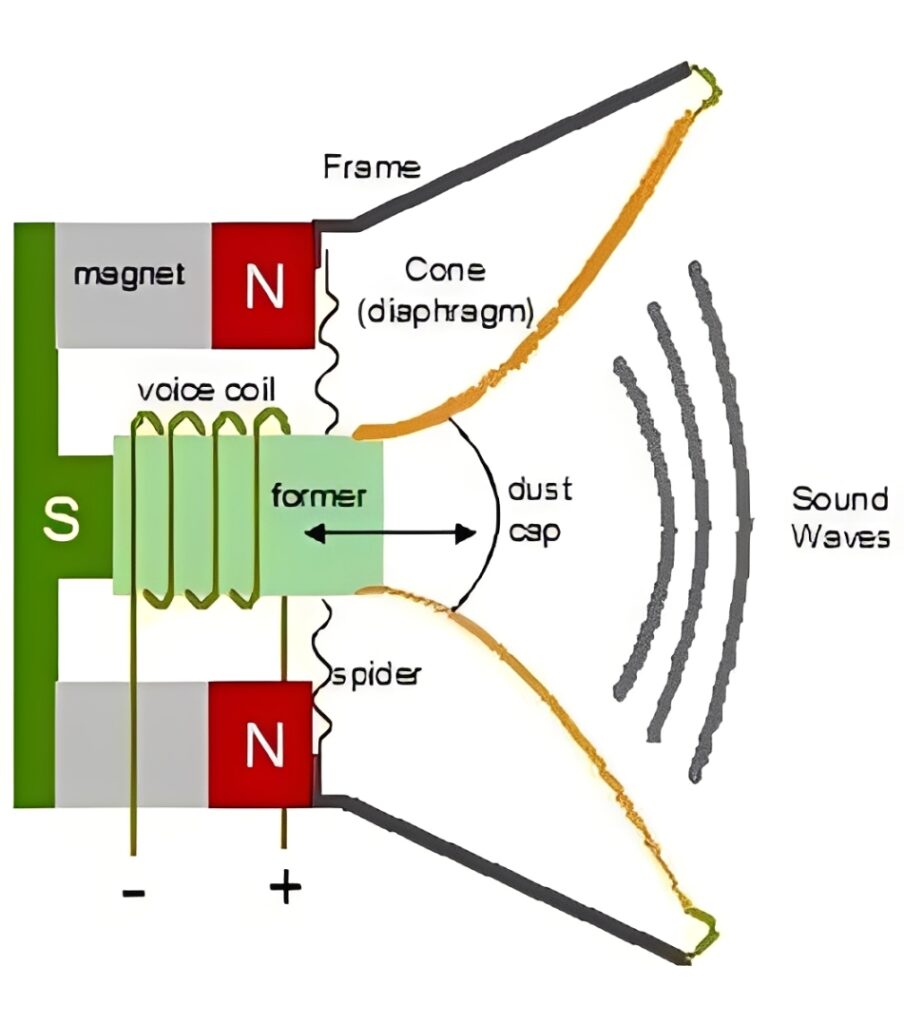
Electrostatic loudspeakers use a different approach. They use a very thin plastic membrane (diaphragm) suspended between two perforated metal sheets, which are called “grids” or “stator plates”. A high voltage is applied to the grids, and then an audio signal is applied to the grids, causing the membrane to move. While one grid causes the diaphragm to push, the other causes it to pull, which moves the the diaphragm, thus creating sound waves.
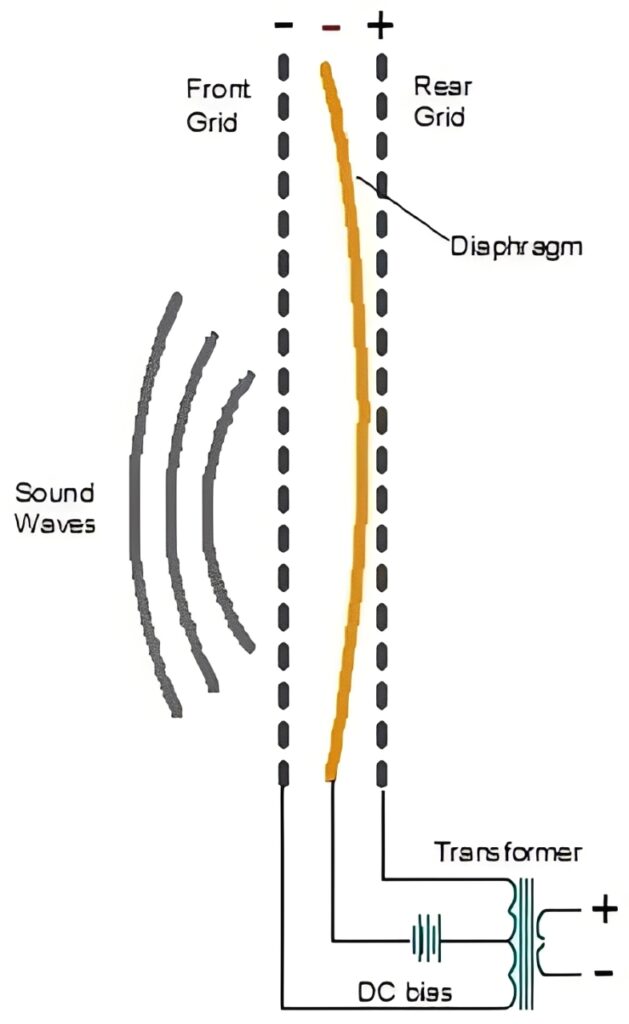
Electrostatic Advantages and Disadvantages
“Electrostatics” have a number of advantages and disadvantages compared to conventional dynamic speakers. Here’s a brief summary….
Low Distortion and Fast Response
The biggest advantages of ESL technology are performance related: they tend to have lower distortion and faster response time compared to dynamic speakers. This is because the moving part of the ESL (the membrane) is very thin and very light, and it is “driven” (controlled) over it’s entire surface. This allows the ESL to accurately and quickly respond to signals from the amplifier.
Limited Power Output and Low Frequency Response
A major disadvantage is that electrostatic loudspeakers are limited in how loud they can play because their membrane (diaphragm) has a limited range of movement (excursion). This disadvantage can be mitigated by using larger electrostatic panels.
This problem is especially limiting at lower frequencies. Producing low frequencies requires the driver to move a lot of air, which is just not feasible with electrostatics. Manufacturers often solve this problem by using a conventional dynamic subwoofer for low frequencies in conjunction with electrostatic panels for high frequencies.
Large Size and Aesthetic Requirements
Because of their limited power output, electrostatic panels are often constructed as very large panels. They also radiate sound from both the front and the rear, so they often need to be placed away from walls. As a result, they take up a lot of space in the listening room, and many people do not like the aesthetics of such large speakers.
Limited High Frequency Dispersion
Another problem with electrostatic speakers is that they have limited high-frequency dispersion because their large, flat panel acts as a single radiator. When a sound’s wavelength (high frequencies have short ones) is smaller than the panel’s width, the sound is focused or “beamed” straight ahead. This effect creates a small “sweet spot” where the treble sounds best. Manufacturers often use curved electrostatic panels to broaden the dispersion.
Need for a High Voltage Power Supply
Lastly, electrostatic speakers have special power requirements; they require a high voltage power supply to charge the diaphragm, and a high-voltage output from the amplifier. This drives up the cost of the system, and often requires that each speaker be plugged into a power source.
Electrostatic Loudspeaker Inventors
The development of electrostatic loudspeakers involved many people, but the technology was made practical and commercially successful primarily by three major inventors: Edward Kellogg, Arthur Janszen, and Peter Walker.
Edward Kellogg
Edward Kellogg was perhaps most famous for co-inventing (with Chester Rice) the modern dynamic loudspeaker in 1925. However, their earlier research at Bell Labs also included significant work on electrostatic designs.
In the early 1920s, Kellogg and Rice were impressed by an enormous prototype electrostatic speaker, noting its superior realism and instrumental timbre reproduction compared to existing acoustic phonographs. They dedicated considerable time to researching the electrostatic principle. Ultimately, Bell Labs rejected the design for commercial use because the large size required for adequate low-frequency reproduction was deemed unacceptable. Despite this, Kellogg continued his work, and patented an improved electrostatic loudspeaker design in 1934 (U.S. patent 1,983,377). Kellogg never did build a commercially successful electrostatic speaker, but he certainly laid the groundwork for future inventors to do so.
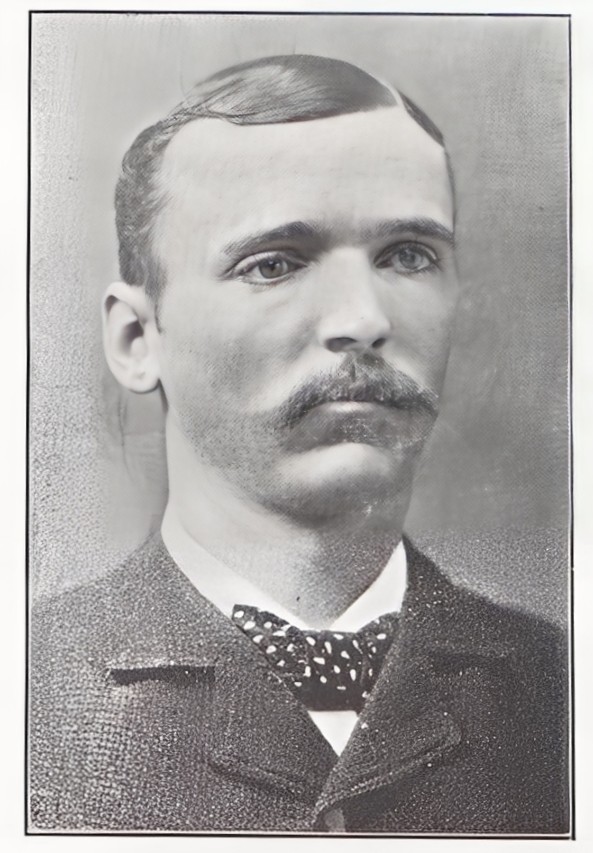
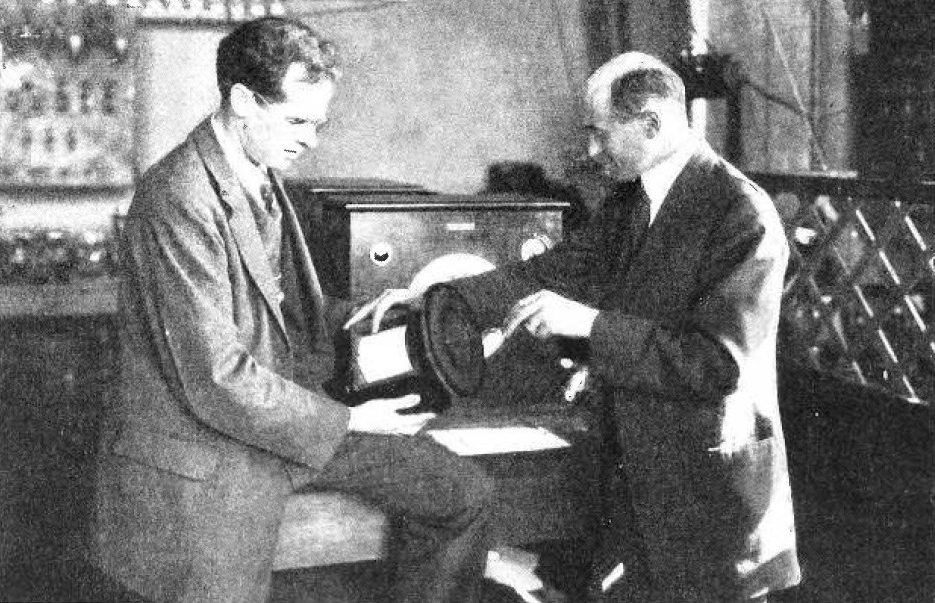
Arthur Janszen
Arthur Janszen worked as a Research Professor at Harvard University’s Underwater Sound Laboratory during World War II. As a physicist engaged in developing a U.S. Navy homing torpedo, he required a sound emitter, or transducer, capable of generating sound with virtually perfect transient response for accurate hydrophone testing. Dissatisfied with the sluggish and inaccurate performance of the cone speakers available at the time, Janszen turned his attention to the electrostatic principle.
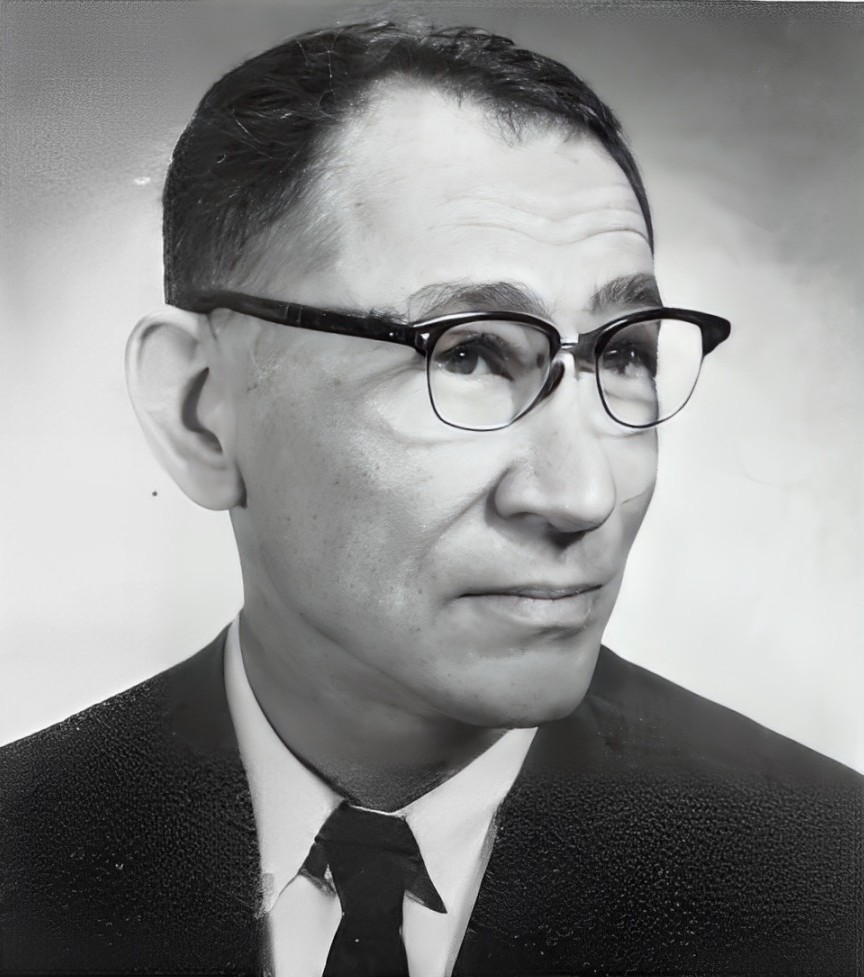
He realized that ESLs were inherently more linear and accurate than dynamic cone drivers. His prototype, built with a thin plastic diaphragm and a conductive coating, confirmed this. It demonstrated a remarkably accurate transient response, cleanly reproducing the sharp onsets and decays of test signals, such as sine wave bursts, without the distortion of ringing, overshoot, or undershoot that plagued traditional speakers.
Following his war-time research, Janszen founded Janszen Laboratory in 1955 to bring this superior fidelity to the home listener. Recognizing the manufacturing complexity of a full-range ESL, he strategically first developed and released the Janszen 1-30 electrostatic tweeter array. This component became highly popular in high-end audio circles, often integrated with existing bass drivers, most notably the Acoustic Research AR-1, to elevate its high-frequency performance.
The culmination of his efforts occurred in the 1960s when Janszen joined KLH to develop the iconic KLH Model 9 loudspeaker, which was a towering, full-range ESL system. Characterized by its massive panels and a powerful 6000-volt polarizing power supply, the KLH 9 became a legendary reference standard for detail and transparency. Janszen continued to refine the technology, later developing another full-range ESL, the Acoustech X, for a division of Koss.
For decades, his groundbreaking tweeter designs were licensed and sold under the Janszen Laboratory and JansZen Electrostatic brands. Today, the tradition of high-quality electrostatic design continues with the JansZen Audio company, run by his son, David Janszen, securing Arthur Janszen’s legacy as one of the true pioneers of high-fidelity sound reproduction.
Peter Walker
Peter Walker, the founder of the Acoustical Manufacturing Company (later known as QUAD), was another important figure in transitioning the electrostatic loudspeaker (ESL) from a theoretical curiosity into a commercially viable and universally respected Hi-Fi component. Walker’s engineering genius solved the manufacturing and performance hurdles that had previously kept ESLs confined to research labs.
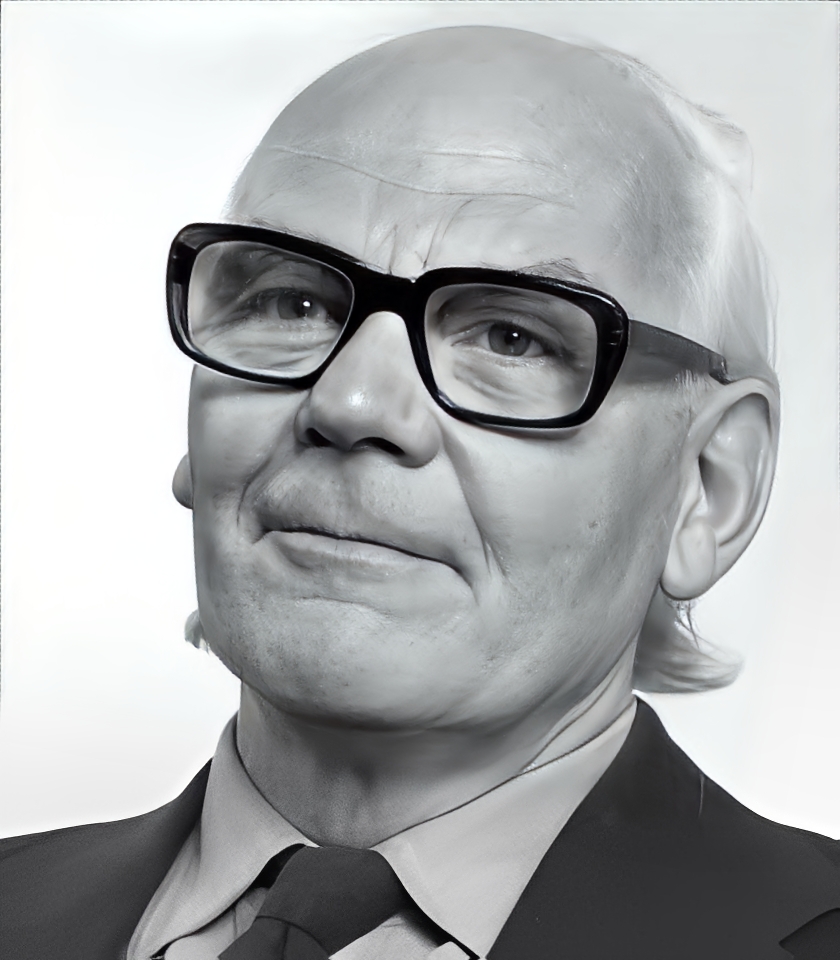
Walker’s defining contribution was the introduction of the Quad Electrostatic Loudspeaker in 1957 (often referred to as the ESL 57). While he was not the first to explore the concept, Walker was the first to successfully address the challenges of building a reliable, full-range ESL for the consumer market. His success was enabled by combining sound engineering principles with the newly available, durable, and lightweight Mylar film developed by DuPont.
The ESL 57 was an open-back, dipole design that used a virtually massless diaphragm, providing a clarity, speed, and lack of coloration that was revolutionary compared to the traditional moving-coil cone speakers of the time. The speaker immediately set a benchmark for sonic accuracy, becoming a ubiquitous reference tool for audio engineers and critics. The sheer realism of the midrange and treble frequencies was unprecedented, cementing the ESL’s reputation as the ultimate transducer for transparency.
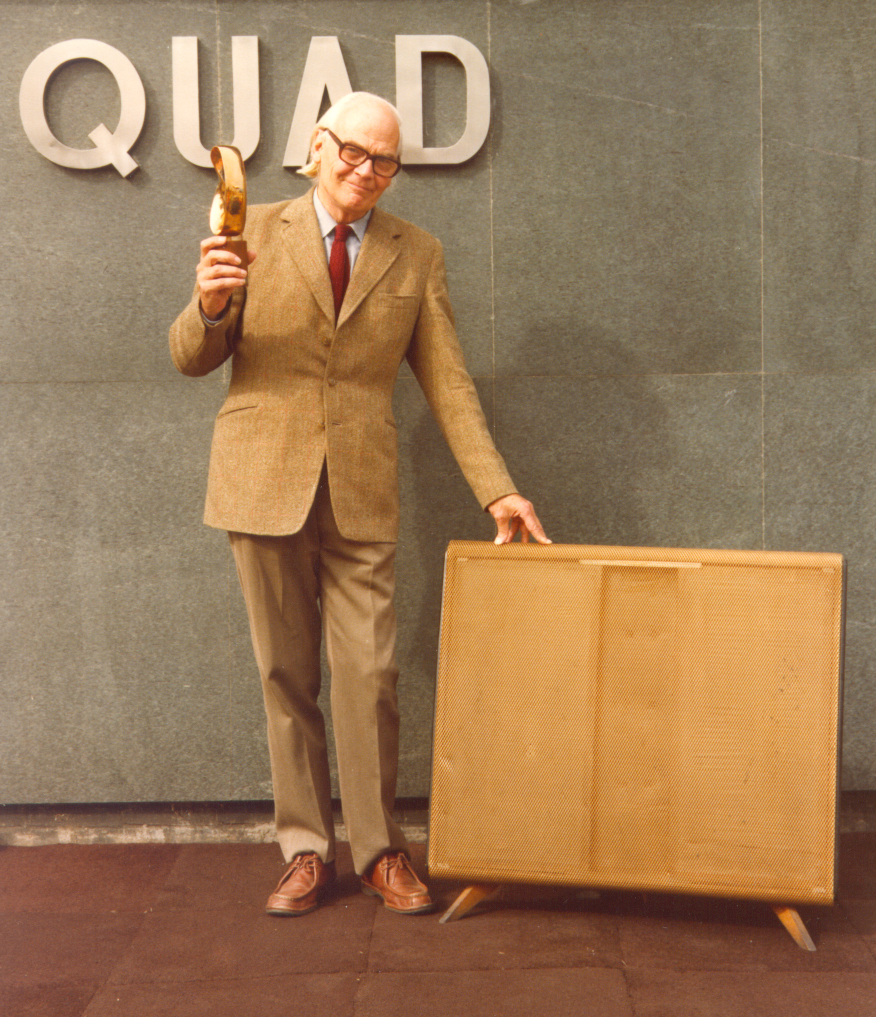
Despite the success of the ESL 57, Walker recognized its inherent limitations: restricted bass output, limited maximum volume, and highly directional high-frequency dispersion (a narrow “sweet spot”). In a monumental follow-up effort, he released the Quad ESL 63 in 1981.
The ESL 63 was a masterpiece of electroacoustic engineering that directly addressed the issue of directionality. Walker’s design used a patented system of concentric annular electrodes fed through sequential delay lines. This method effectively delayed the audio signal to the outer areas of the large planar diaphragm, causing the sound to propagate as if it were emanating from a theoretical point source located behind the panel. This innovation resulted in far wider dispersion, a more coherent soundstage, and greatly improved transient response, thereby extending the ESL’s reign as a standard of fidelity and ensuring Peter Walker’s permanent place as one of the most influential figures in the history of loudspeaker design.
Our “Top Ten” Electrostatic Loudspeakers
Since they were first developed in the 1950s, there have been many electrostatic loudspeakers produced. We’re going to look at ten of the most notable designs. Don’t worry, headphone fans, we haven’t forgotten about you, we’ll look at some electrostatic headphones too.
#1 – JansZen 1-30 Tweeter
The JansZen Model 1-30, introduced around 1954 by Arthur Janszen, was the world’s first commercially practical electrostatic hi-fi speaker. It was designed not as a full-range speaker, but as an add-on tweeter/midrange array to improve high-frequency reproduction in existing systems.
The unit consisted of four push-pull electrostatic radiators angled to provide a wide 120-degree horizontal sound dispersion. With an impressive frequency response extending beyond 30,000 Hz, the 1-30 was renowned for its transparency, superior transient response, and exceptionally low distortion above 1000 Hz. It was popularly paired with the Acoustic Research AR-1 speaker to create one of the era’s definitive high-end loudspeaker systems.
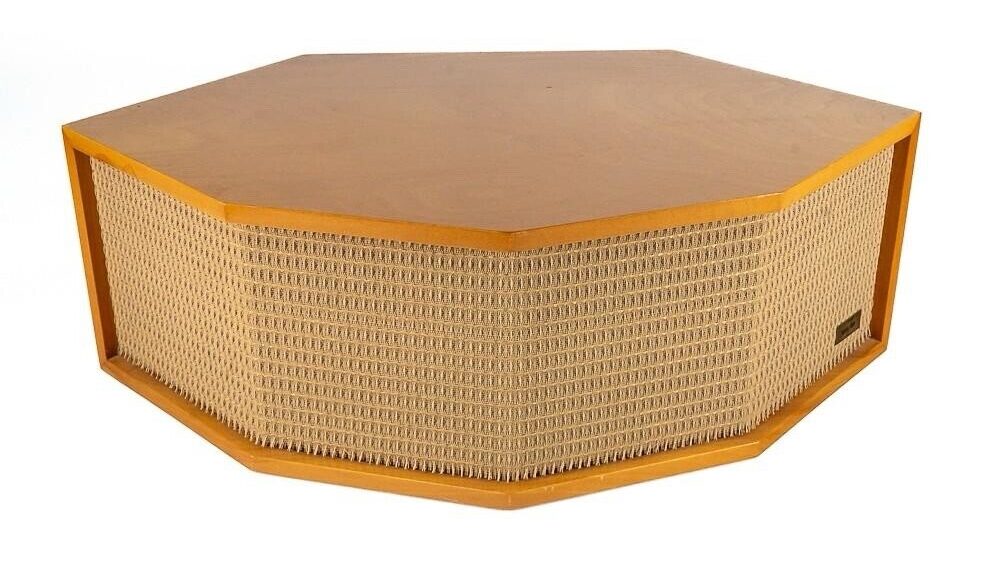
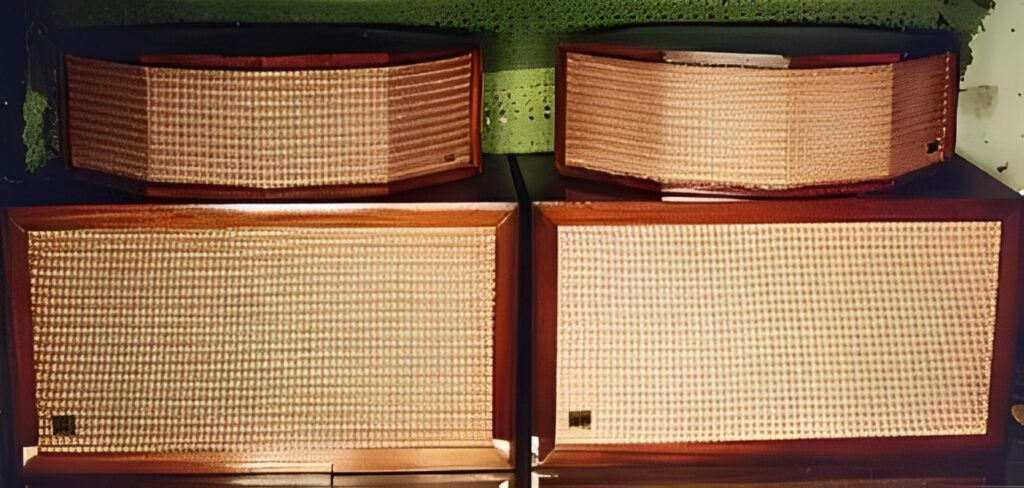
#2 – Quad ESL-57
As described earlier, the Quad ESL-57 was the world’s first full range electrostatic speaker. Launched in 1957, it remains one of the most revered speakers in history for its transparency, speed, and peerless midrange clarity.
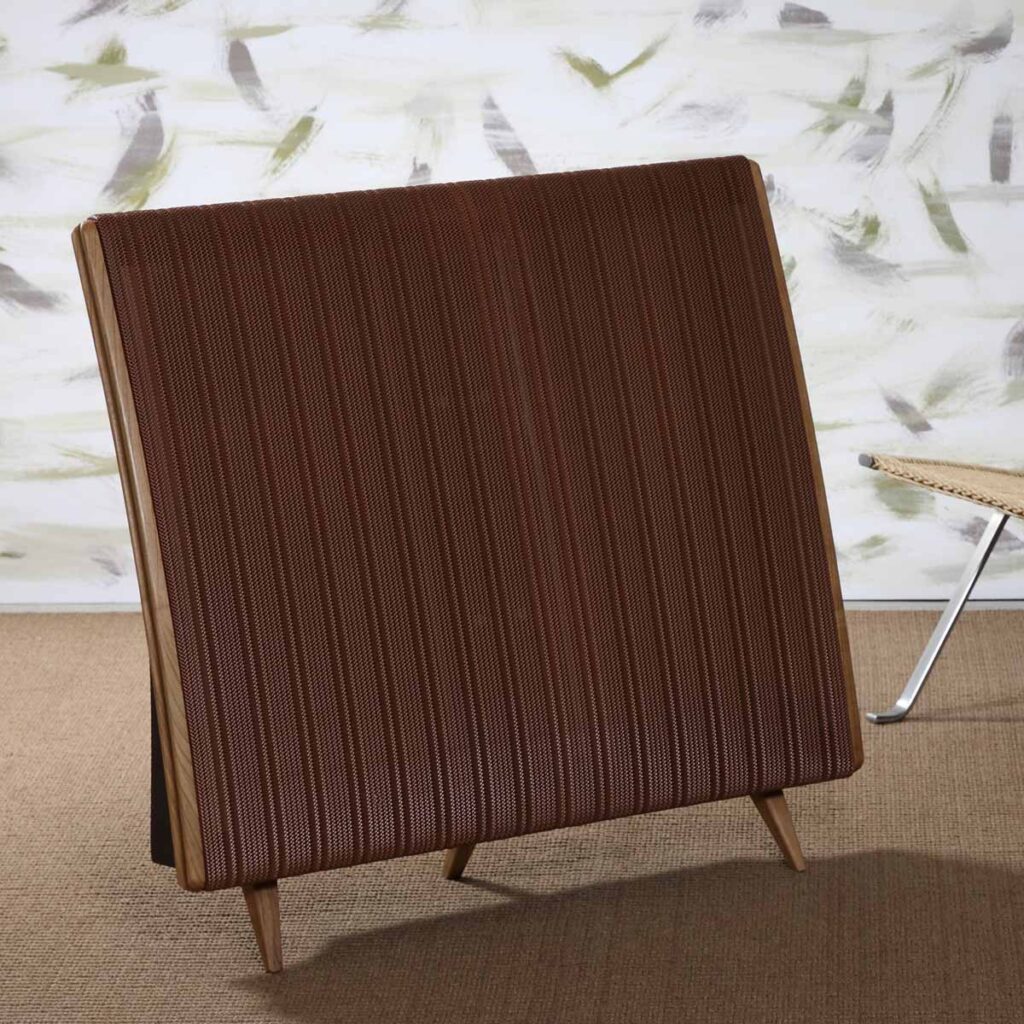
Quad continues to manufacture electrostatic speakers. Their current lineup includes the ESL 2812 and ESL 2912. Click here to see the Quad website.
#3 – JansZen “Z” Series
The JansZen Z-series loudspeakers, prominent in the 1960s, are notable examples of hybrid electrostatic designs. Developed by Arthur Janszen, these speakers paired a conventional dynamic woofer (often a 10-inch acoustic suspension design) for the bass frequencies with Janszen’s patented electrostatic tweeter panels for the midrange and treble.
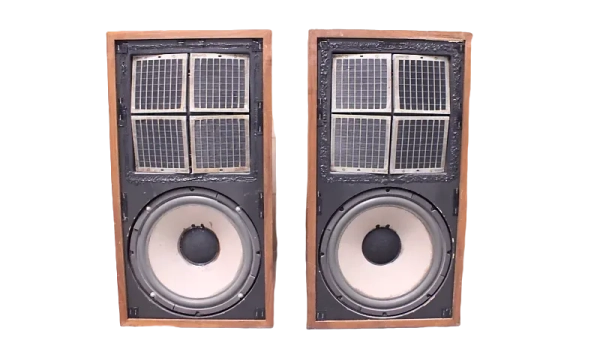
Models in the Z-300, Z-400, Z-600, and Z-900 series were praised for their exceptional transparency, detail, and naturalness, qualities characteristic of electrostatic drivers. They were considered high-fidelity systems, though some early models had treble dispersion limitations. The later Z-series speakers improved upon these designs with multiple tweeter elements and larger cabinets for enhanced bass and power handling.
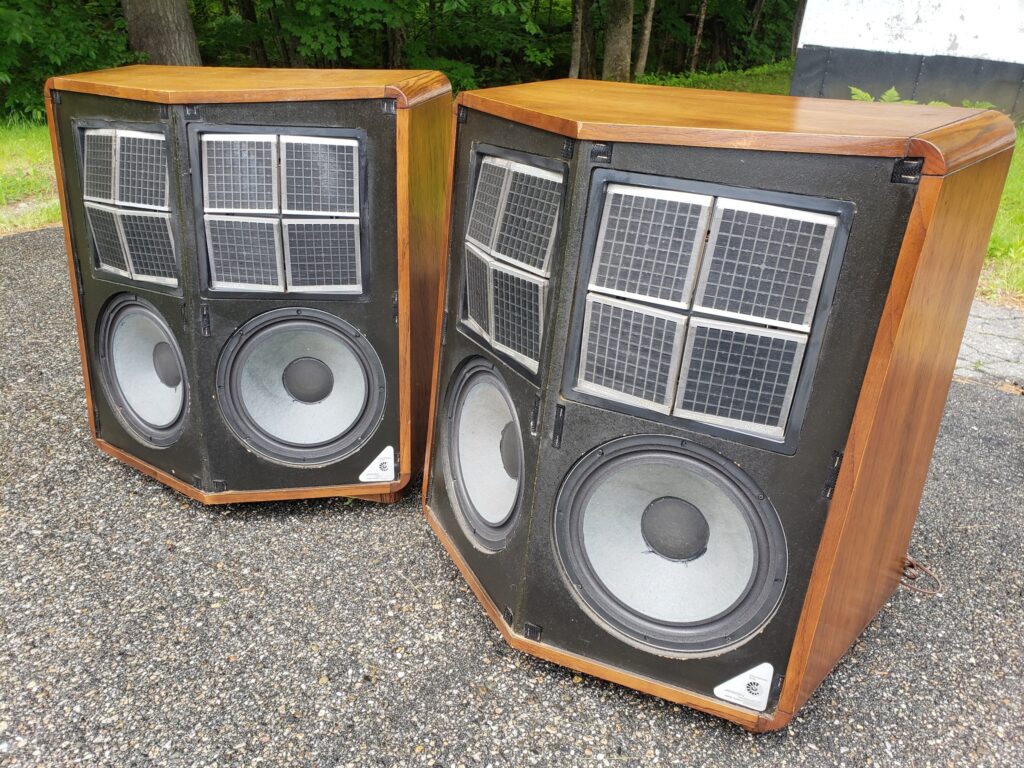
The legacy of these speakers lives on in speakers produced by Janszen Audio, a company which is owned by David Janszen, the son of the late Arthur Janszen. They manufacture a line of electrostatic speakers in Columbus, Ohio. Click here to visit their website.
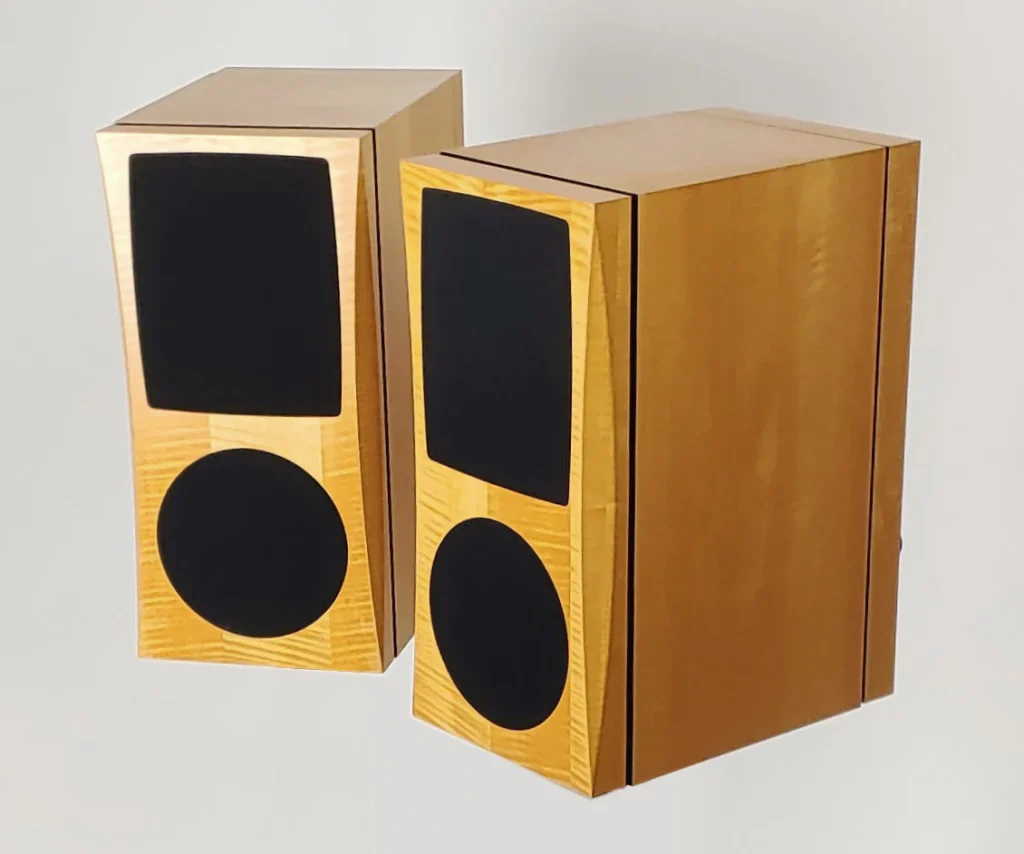
#4 – KLH Model Nine
Launched in the early 1960s, the KLH Model Nine was a massive, full range electrostatic speaker. Designed by Arthur Janszen, it was highly praised for its dynamic range, and is considered one of the all-time great reference speakers. KLH manufactured the Model Nine from 1962 until 1977, when it was discontinued.
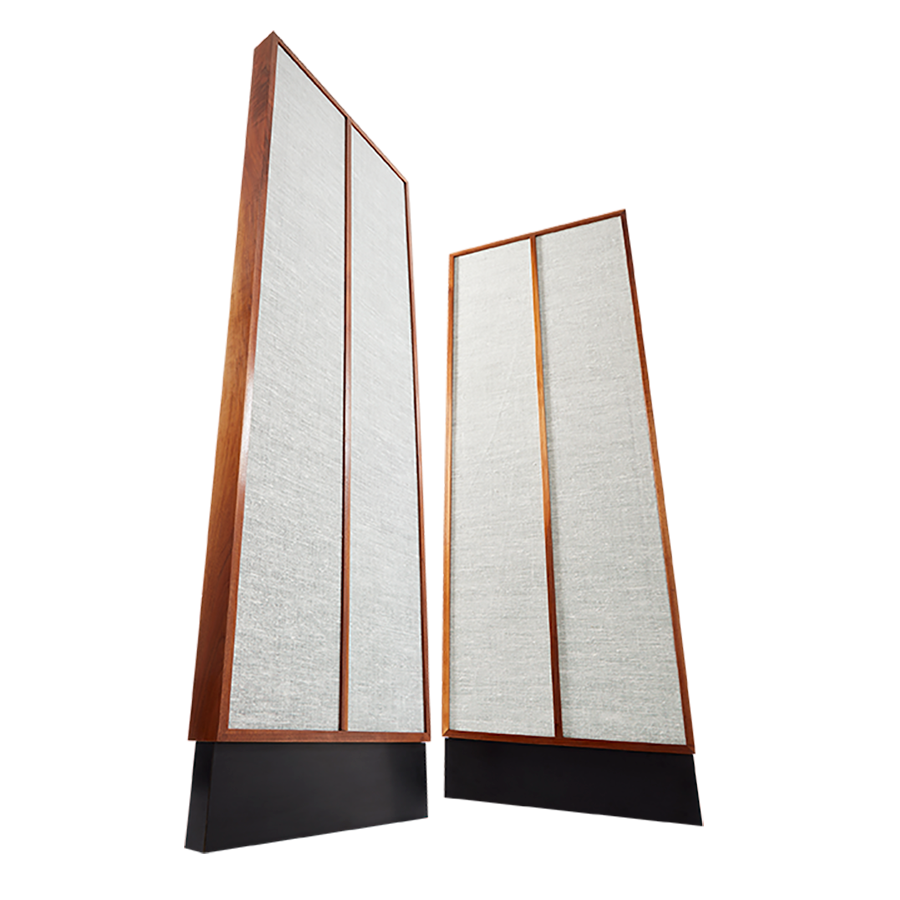
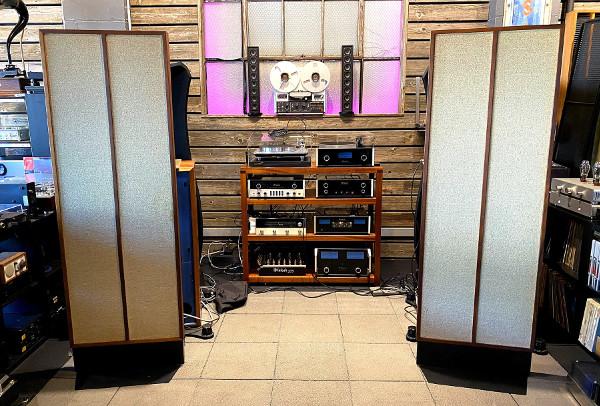
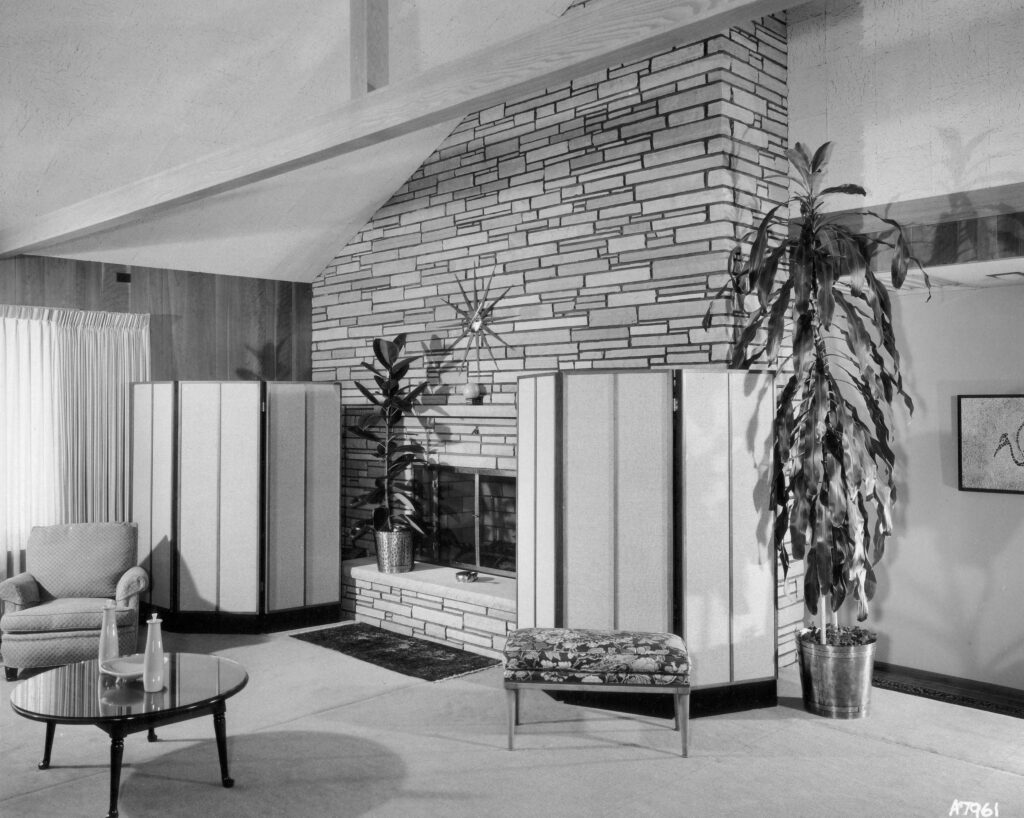
The KLH company faded into obscurity in the 1980s, but the brand was re-launched recently with “refreshed” versions of classic KLH speakers such as the Model Five. So far, there is no news of KLH bringing back the Model Nine. Click here to visit the KLH website.
#5 – Acoustat 2+2
Number 5 on our list is the Acoustat 2+2 loudspeaker, which was introduced around 1984. This was a towering, full-range electrostatic, employing four panels in a two by two configuration. These speakers measured 7 feet, 10 inches (240 cm) tall, and visually dominated the listening room.
The speakers had an immense soundstage, excellent dispersion, and were able to handle high power. With four large panels, they were able to produce more bass than a typical full range electrostatic.
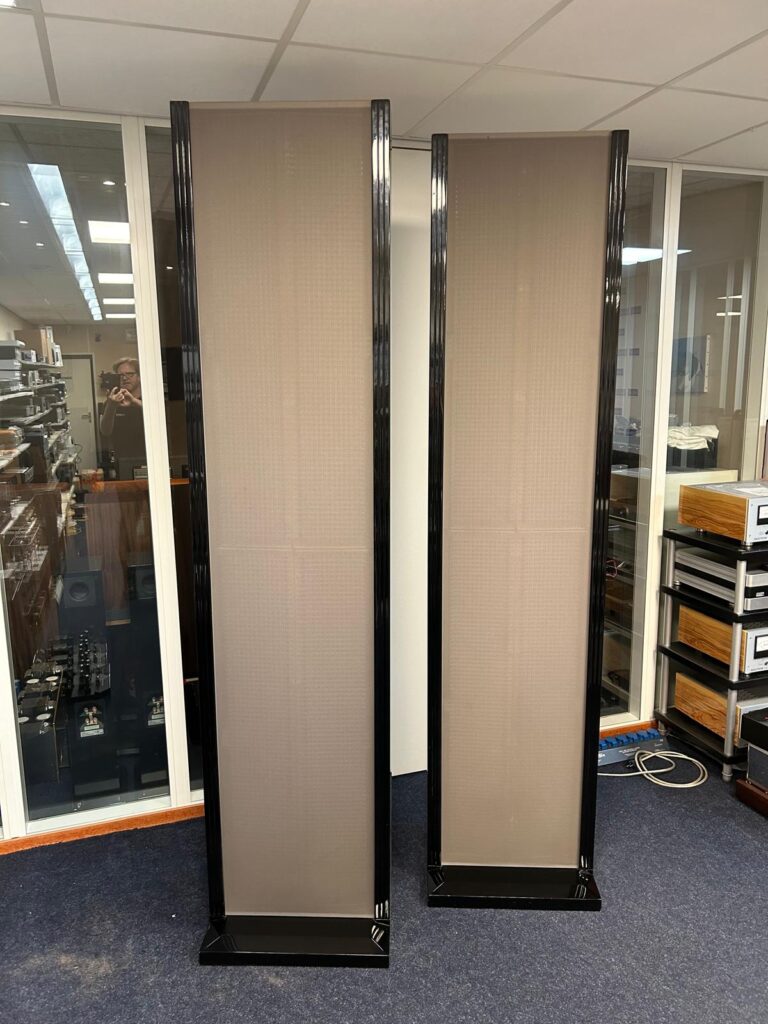
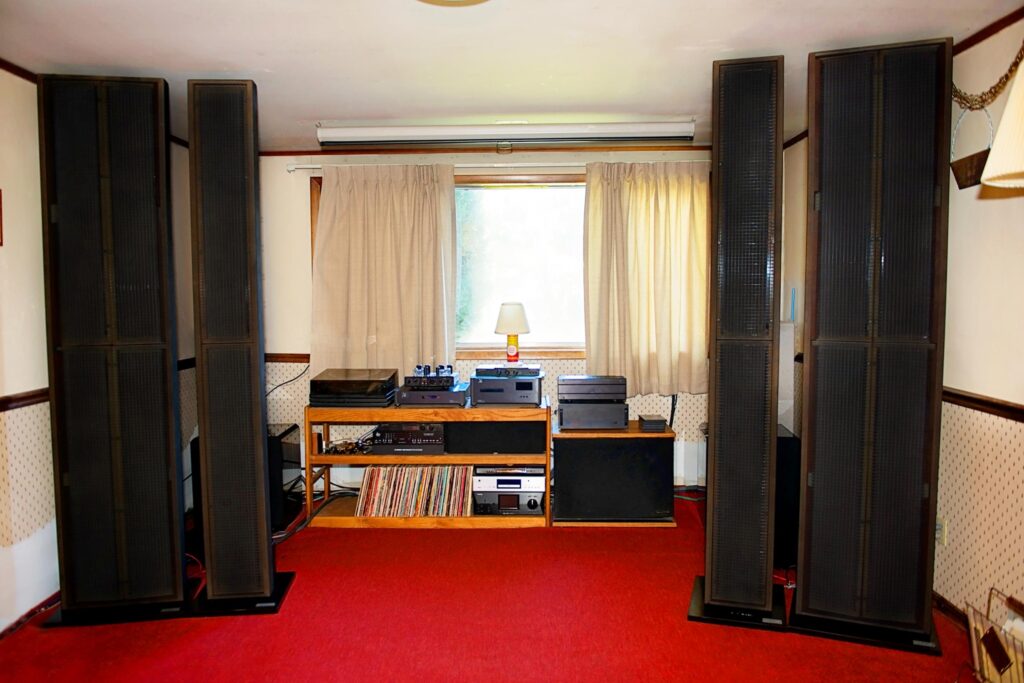
Unfortunately, Acoustat is no longer in business and these speakers are only available in the second hand market.
#6 – Quad ESL-63
The Quad ESL-63 was introduced in 1981, 24 years after the original ESL-57. Designed by Peter Walker, the ESL-63 employed a revolutionary design to broaden the dispersion and provide a larger “sweet spot” for the listener.
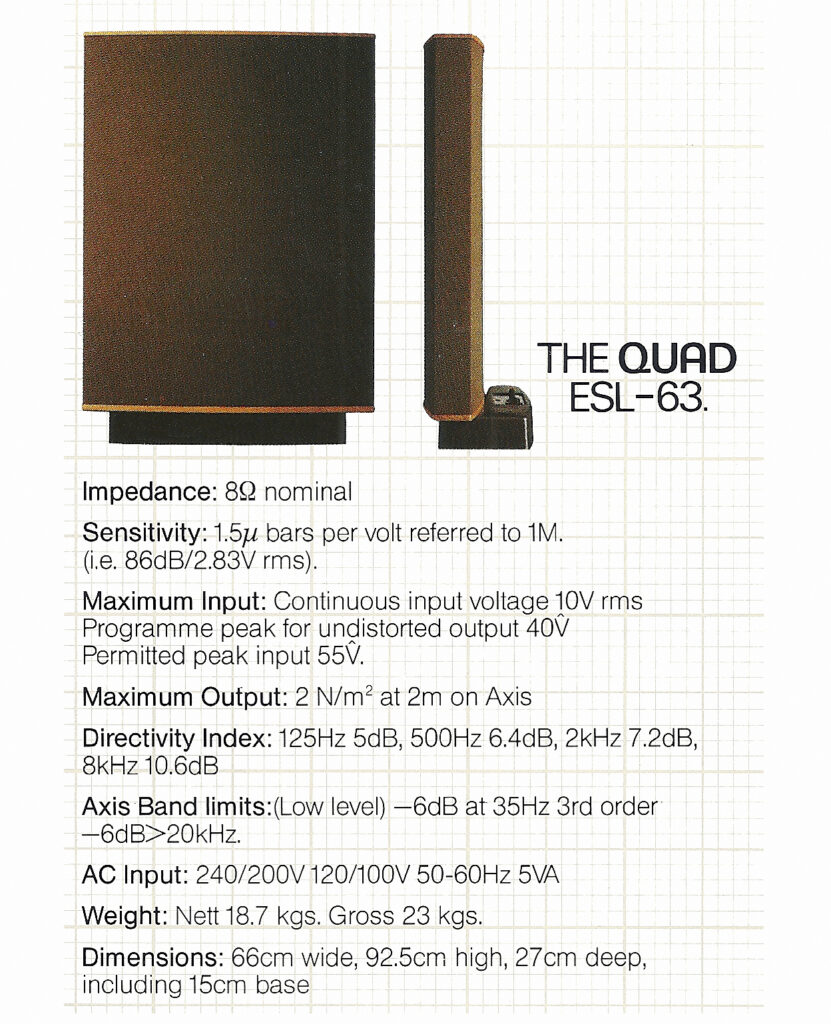
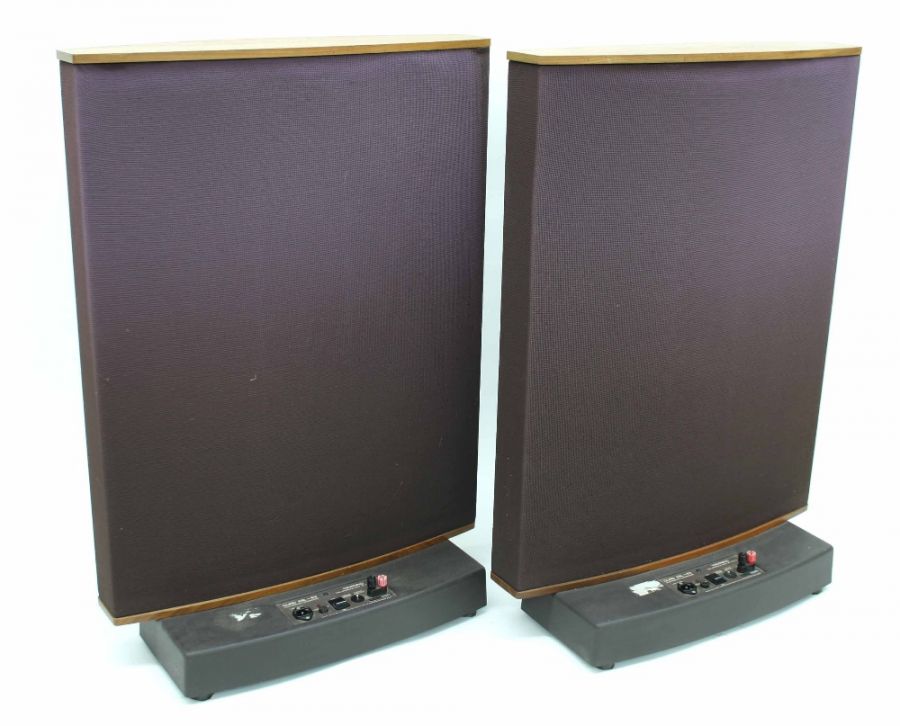
To accomplish this, the ESL-63 employed a concentric ring of electrodes, with electronic delay lines to create a virtual point source. The new speaker also employed a newer diaphragm material called Melinex to provide a more consistent product quality.
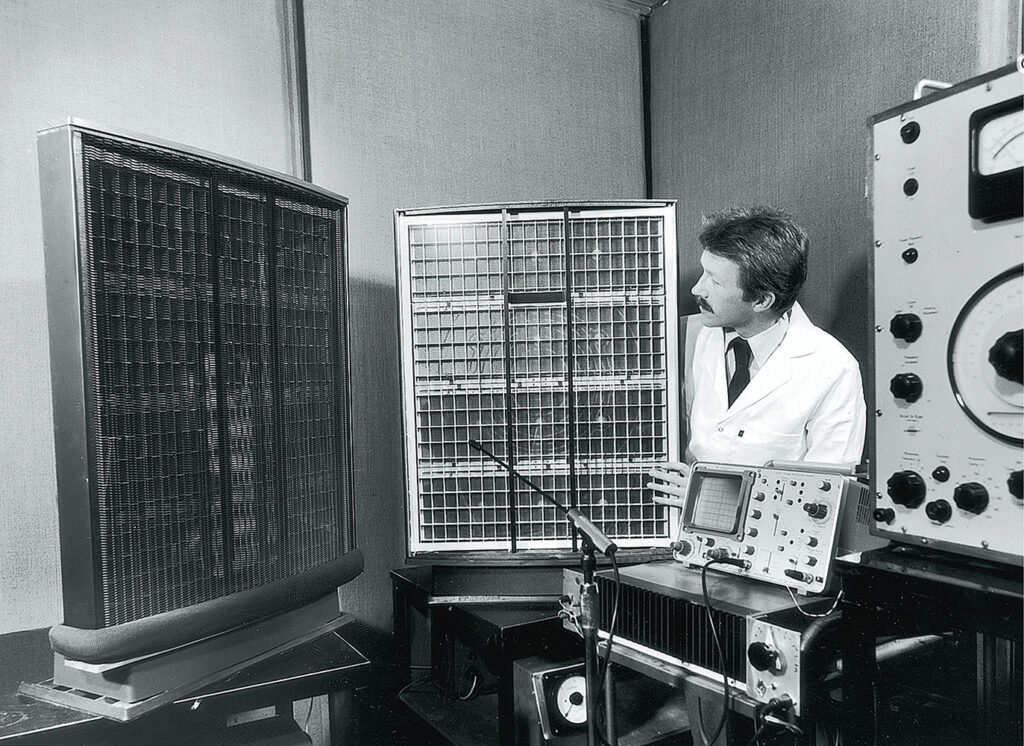
The ESL-63 was in production until 1999, when it was superseded by the ESL-988 and ESL-989 loudspeakers. Click here if you’d like to visit the QUAD website and see the current line of products,
#7 – STAX ELS-8X
STAX is a Japanese Hi-Fi manufacturer that is best known for their electrostatic headphones, but they did produce a number of electrostatic loudspeakers over the years.
The STAX ELS-8X was an exceptional and ambitious design. It was a three-way system, employing four “cells” for the low frequencies, two more cells for the midrange, and two more for the high frequencies.
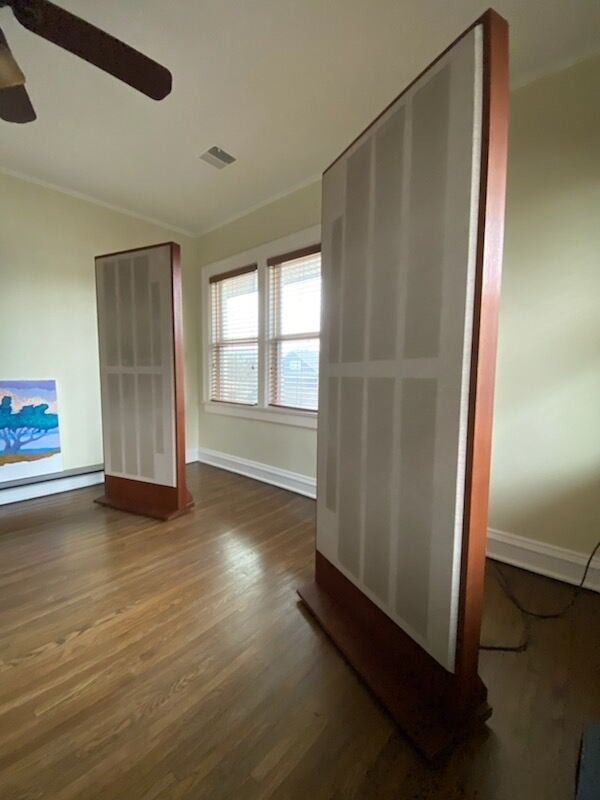
It was available in two versions. The “8X” employed a conventional power supply that plugged into a wall outlet, while the “8X BB” (Battery Bias) employed a battery pack to charge the panels. The battery fed 4400 volts into the low and mid frequency cells and 2200 volts into the tweeters.
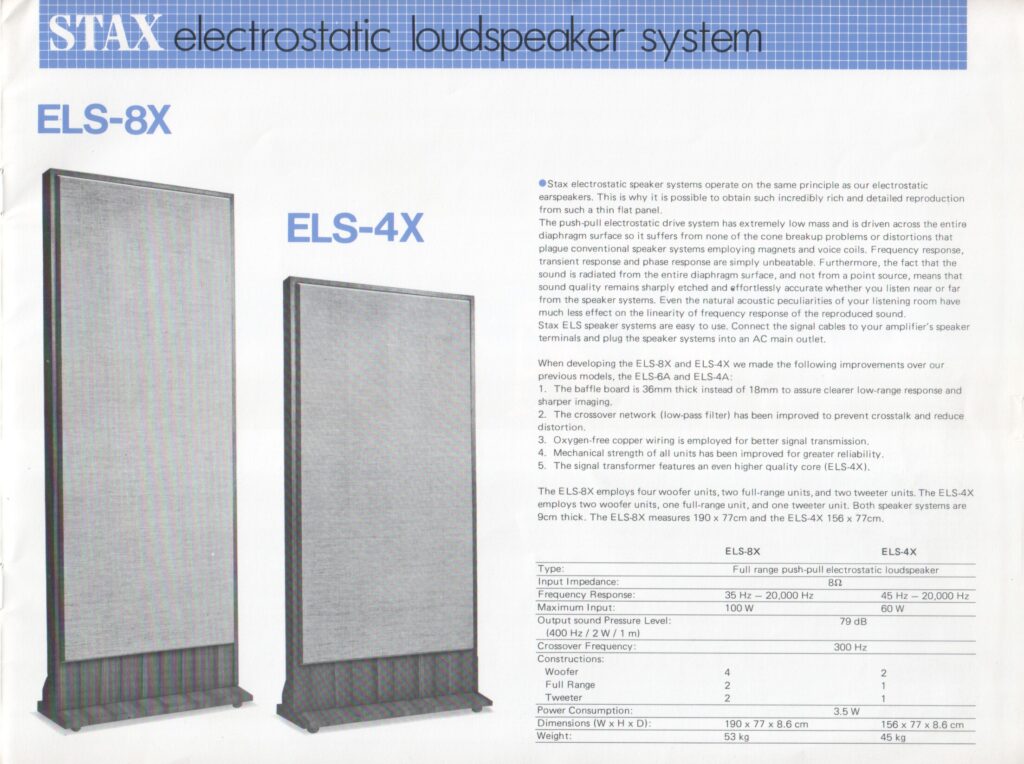
The speakers were large, almost 2 meters (6 feet) tall, and weighing 53 kilograms (116 pounds) each. They were a difficult and inefficient speaker to drive, requiring lots of power. They also had overload protection to prevent damage at high power levels, and could handle a maximum of 100 watts. Definitely not for playing loud! STAX manufactured the ELS-8X from 1982-1988.
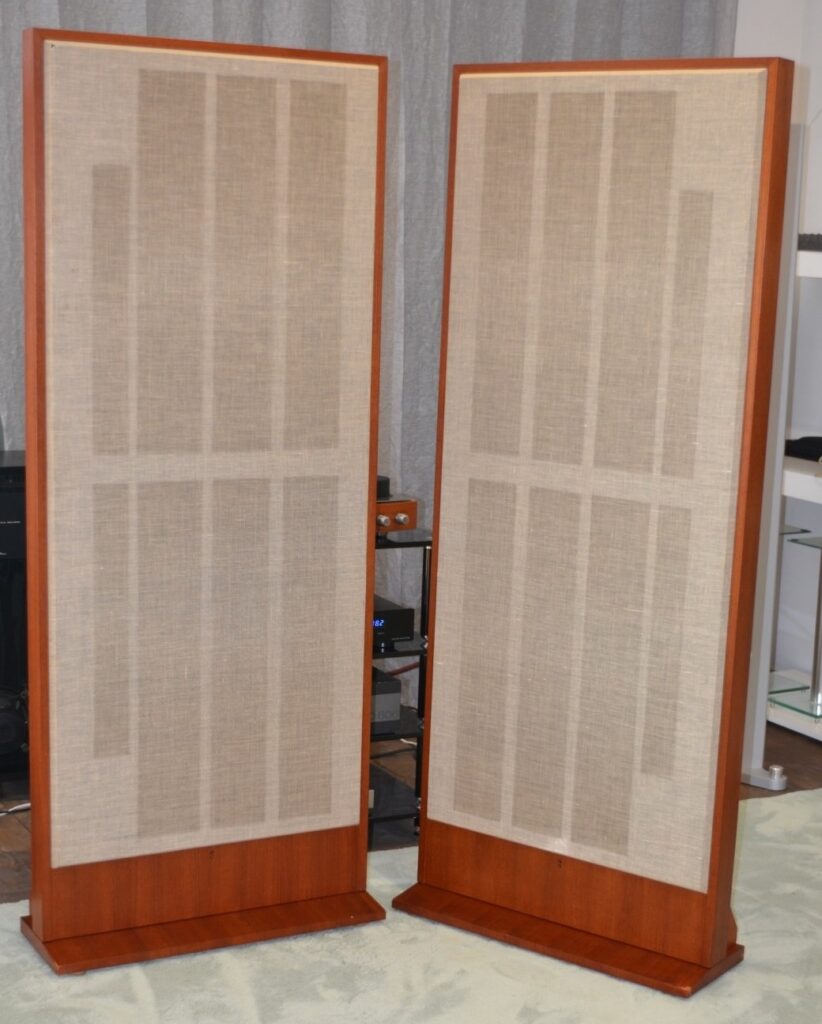
#8 – MartinLogan Monolith
MartinLogan burst onto the Hi-Fi scene with their Monolith speaker in 1982. Designed to merge the speed and detail of an electrostatic transducer with the deep bass authority of a dynamic cone, the Monolith offered a compelling solution to the long-standing challenges of full-range electrostatic speakers. Its primary innovation was the use of a Curvilinear Line Source (CLS) electrostatic panel, which addressed the narrow dispersion issue common to planar designs by curving the thin diaphragm to achieve a wider 30 degree horizontal sound field.
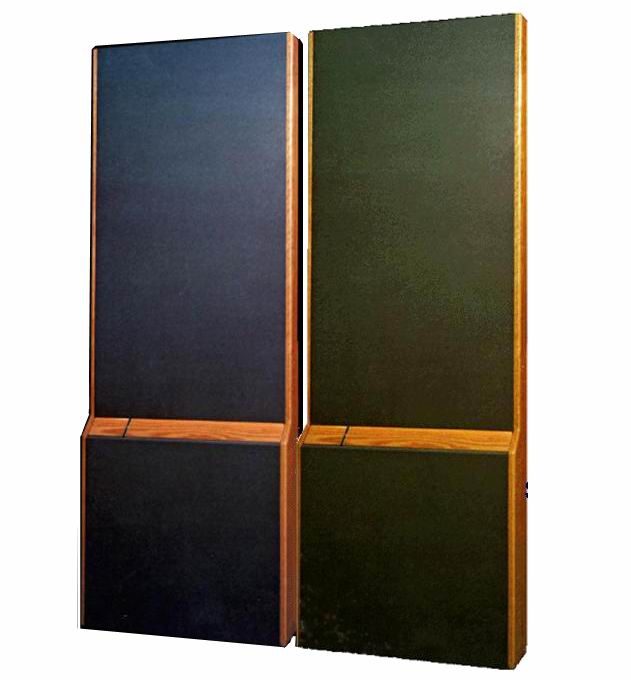
In 1985 they released the Monolith II, refining the materials and construction for greater purity and reliability. Like its predecessor, the Monolith II featured a large, transparent ESL panel mated to a 12 inch woofer, crossing over around 100 Hz.
In 1990, the final major iteration, the Monolith III, introduced more technical advancements. While maintaining the powerful 48 inch CLS transducer and 12 inch woofer, the Mark III model focused heavily on improving the seamless blend between the drivers. This was achieved via a modular crossover concept, offering the passive IIIp Interface or the superior, optional IIIx electronic crossover (Exos). The IIIx allowed for precise bi-amplification and active control, leading to dramatically enhanced bass impact, superior definition, and an “invisible” transition zone at the 125 Hz crossover point, solidifying its reputation as a reference-grade system.
#9 – Sound Lab Majestic Series
Sound Lab was founded in 1978 with the goal of developing full range electrostatic speakers. Their first product was the A-1, but the company worked to refine and improve the quality for many years, developing the Majestic, Ultimate, and Millennium series along the way.
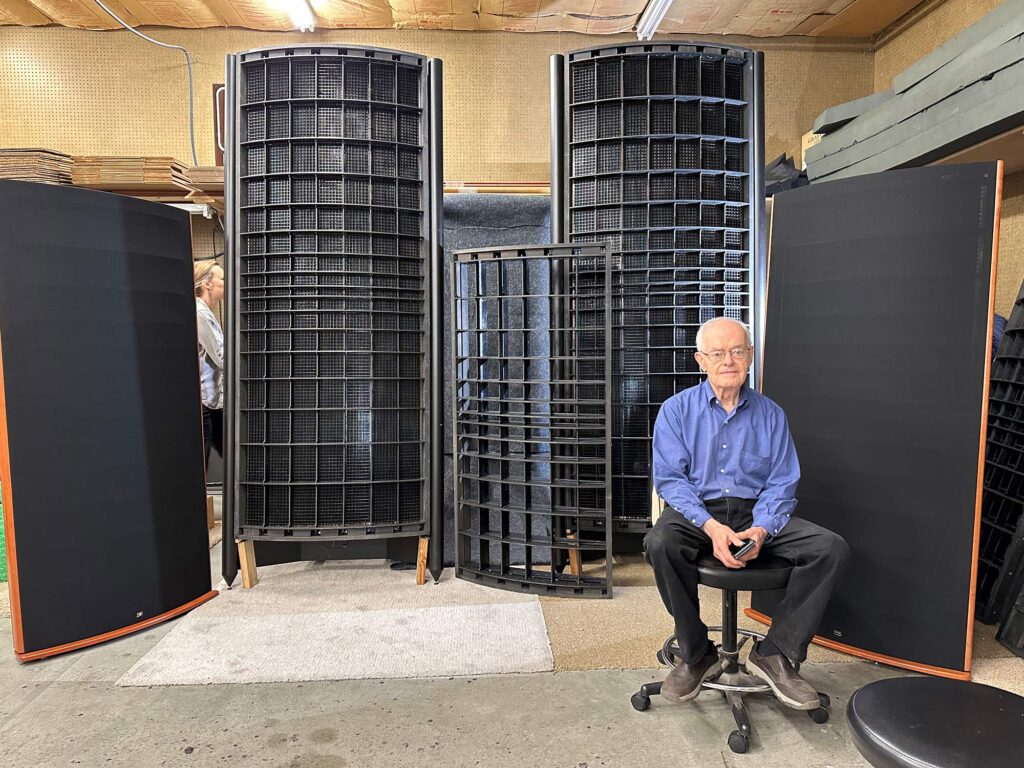
The Sound Lab Majestic 945 (or the newer 945PX upgrade) is a flagship, full-range electrostatic panel loudspeaker renowned for its scale, coherence, and lifelike clarity. Standing nearly nine feet tall, the “945” nomenclature indicates its approximate nine foot height and 45-degree curved radiating surface.
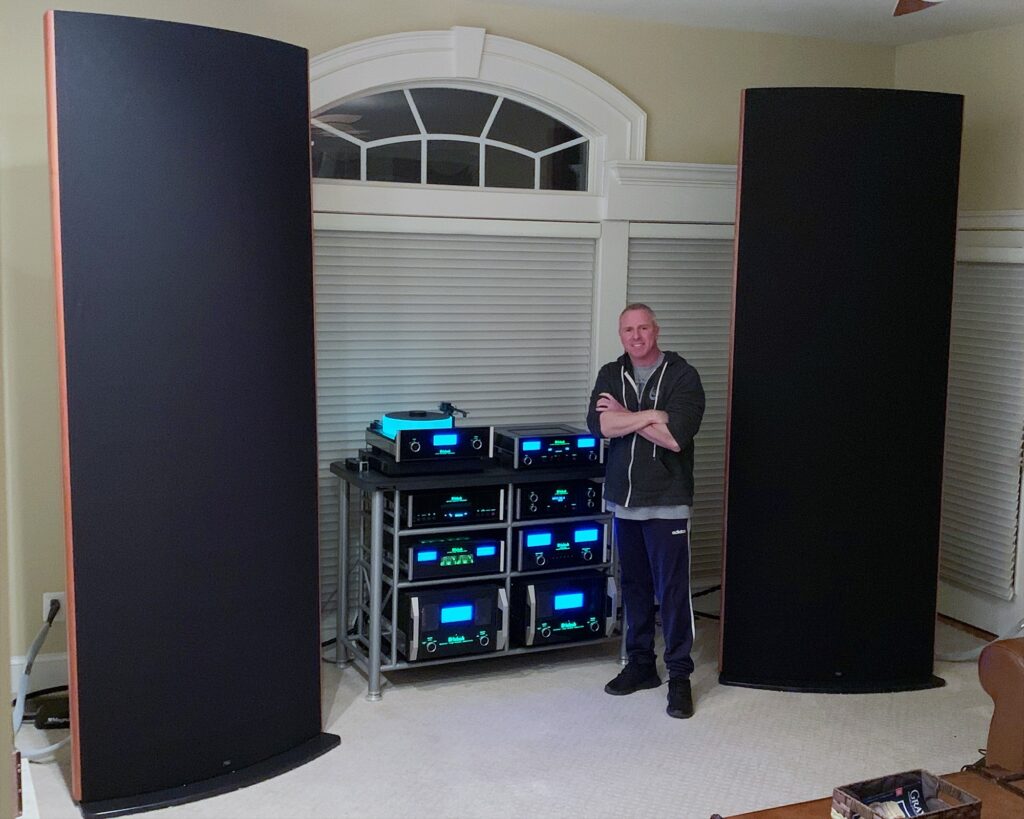
This colossal size is critical, as the speaker employs a single Mylar diaphragm, which acts as a true line-source to eliminate enclosure coloration and provide uniform sound dispersion from floor to ceiling. The 45-degree curve ensures a controlled horizontal dispersion, widening the listening “sweet spot” compared to flat panels.
Sonically, the Majestic 945 is praised by audiophiles for delivering extraordinary tonal nuance, articulation, and scale. It achieves genuine, deep bass down to 24 Hz without needing a separate dynamic woofer, an exceptional feat for an electrostatic design. On the back, it features comprehensive, continuously adjustable controls for Brilliance and Low Frequency levels, allowing users to acoustically tune the speaker to their room and personal taste. These 221 pound (100 kg) dipole speakers are designed to reproduce music with astonishing realism, from a gentle raindrop to the power of thunder.
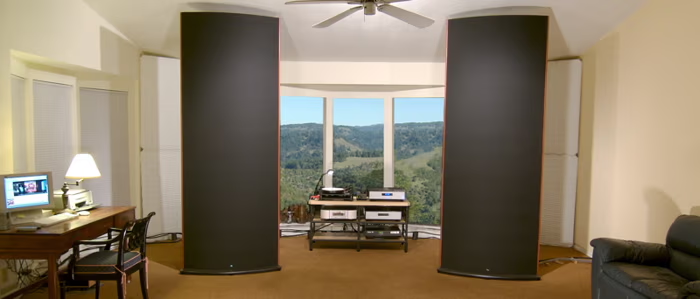
The Majestics are still available today, along with a range of other designs. Click here to visit the Sound Lab website.
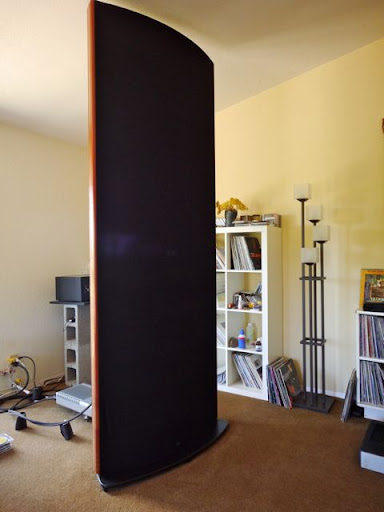
#10 – MartinLogan Neolith
We’re going to wrap up our “Top Ten” list with another MartinLogan speaker: their current flagship electrostatic speaker, the Neolith. Introduced in 2014, the Neolith is a massive, no-compromise design that represents the pinnacle of MartinLogan’s hybrid technology, featuring a huge, advanced electrostatic panel and powerful dynamic woofers.
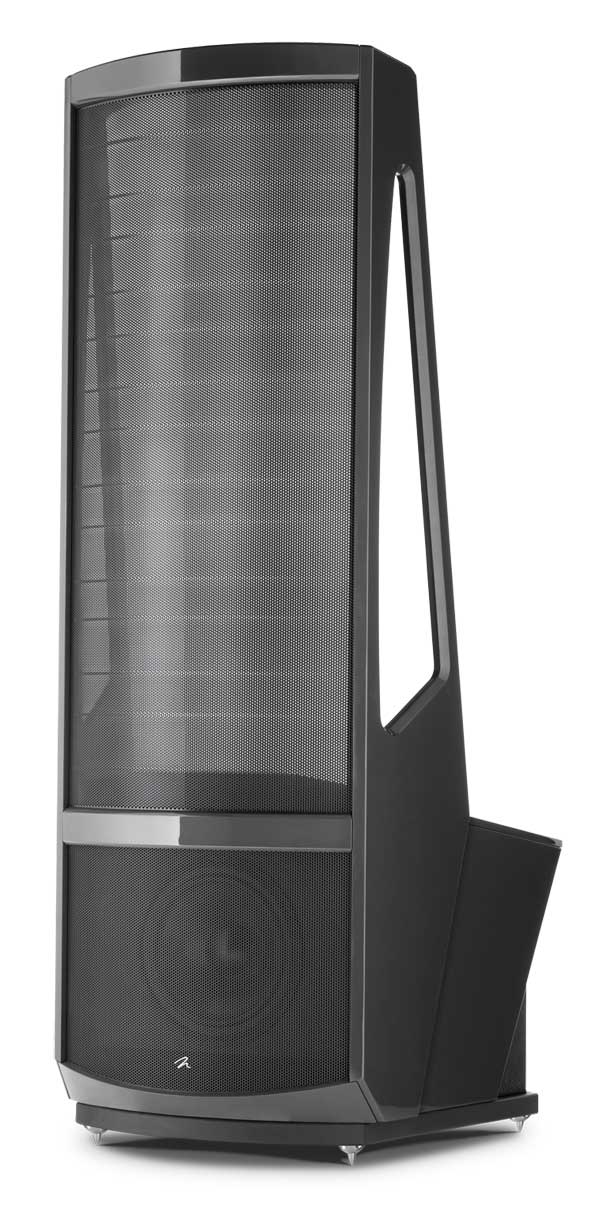
Its defining feature is a 48″ x 22″ Curvilinear Line Source (CLS) electrostatic panel for the mid-to-high frequencies, which operates like a true dipole to minimize side-wall reflections. For deep, authoritative bass down to 23 Hz, the speaker employs two powerful passive woofers: a 12-inch front-firing sealed mid-bass driver and a 15-inch rear-firing ported subwoofer.
The Neolith is approximately six feet tall and weighs 385 pounds (175 kg). It features a sophisticated crossover with custom tuning controls to adjust bass output and panel-to-woofer integration based on listening distance. This design seamlessly blends the speed and detail of the massless electrostatic panel with the dynamic power of traditional cone woofers.
Martin-Logan continues to make a wide range of superb speakers. Their flagship products employ electrostatic technology, but they also make speakers using other advanced technologies such as thin film and “folded motion” drivers. Click here to see the MartinLogan website.
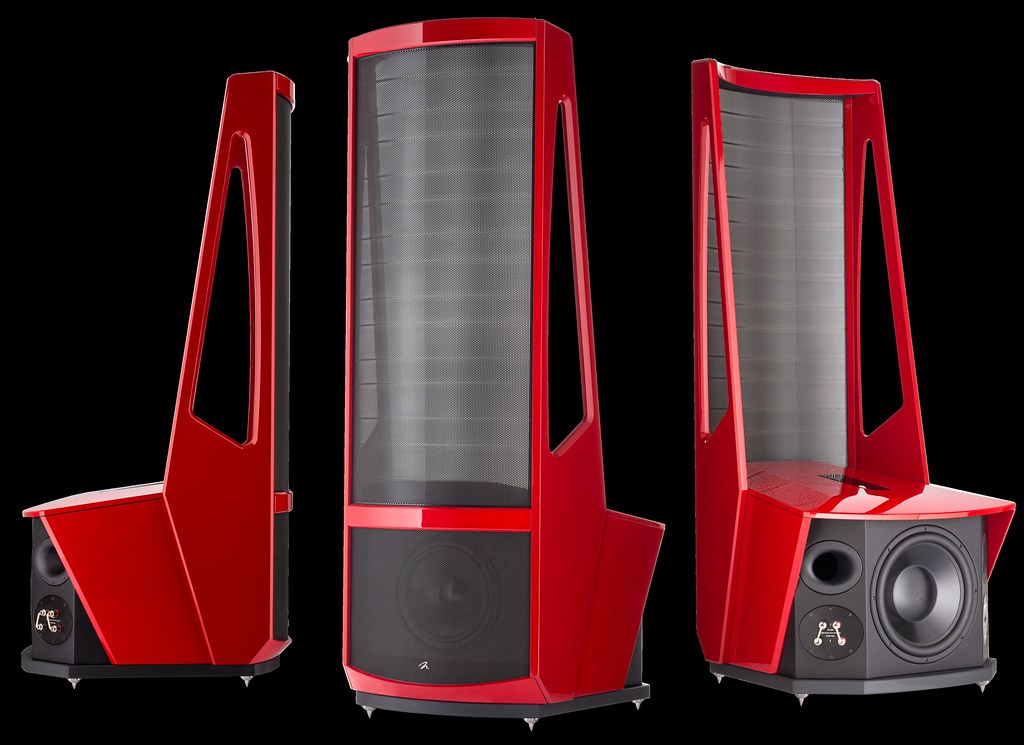
Electrostatic Headphones
The same electrostatic technology that is used for speakers can be miniaturized and used for headphones. Just a few years after the first electrostatic speaker was introduced, STAX produced the world’s first electrostatic headphones. Let’s take a look at three headphone manufacturers that have produced electrostatic headphones, along with some of their iconic models.
STAX
Our first entry is from STAX. STAX was founded in 1938 and originally focused on recording equipment, but later switched to producing Hi-Fi equipment. STAX introduced their first electrostatic headphone model, the SR-1, around 1960. Note that STAX always refer to their headphones as “earspeakers” rather than as headphones, to differentiate them from other manufacturers.
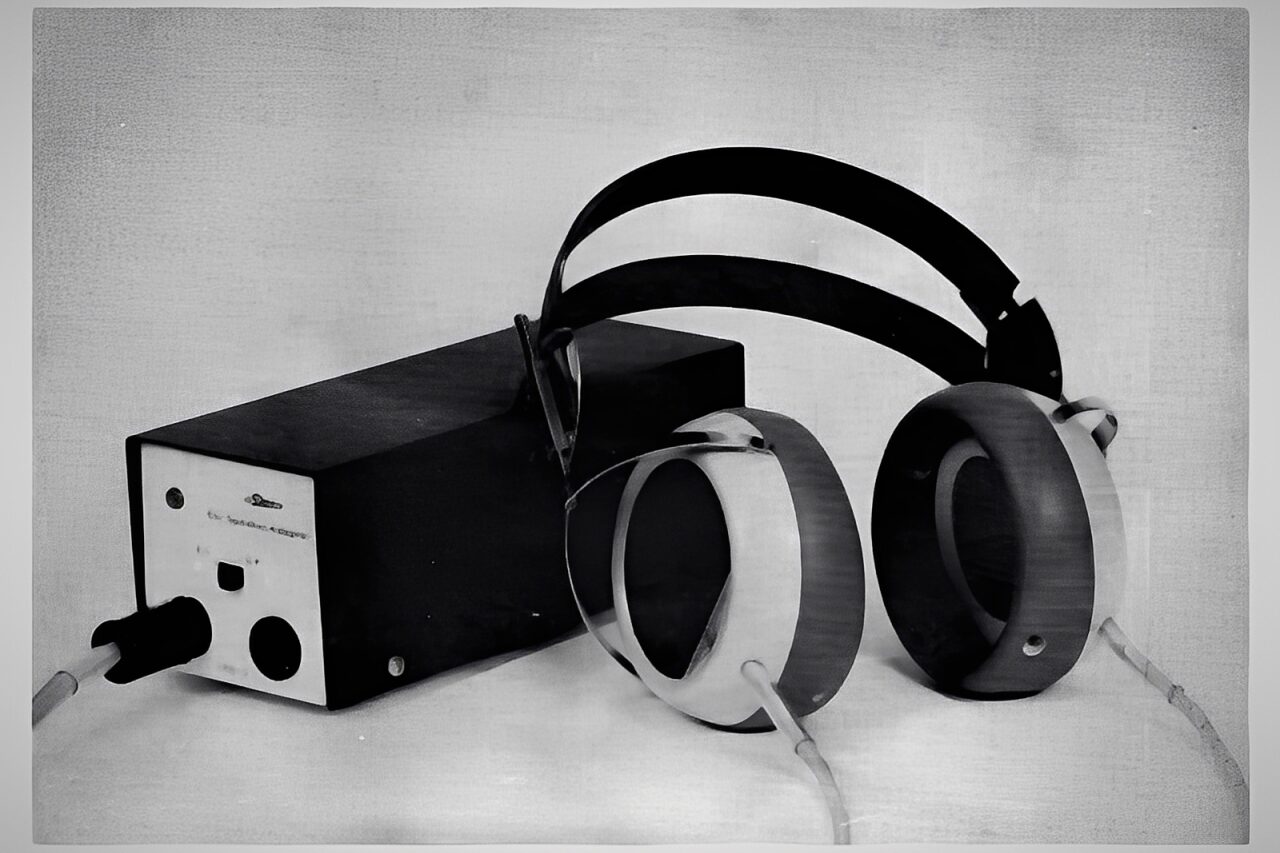
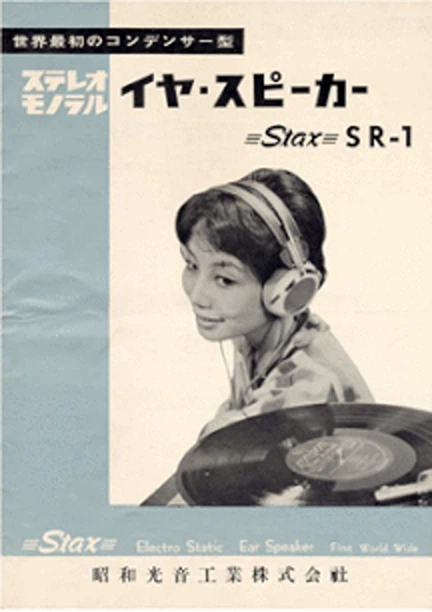
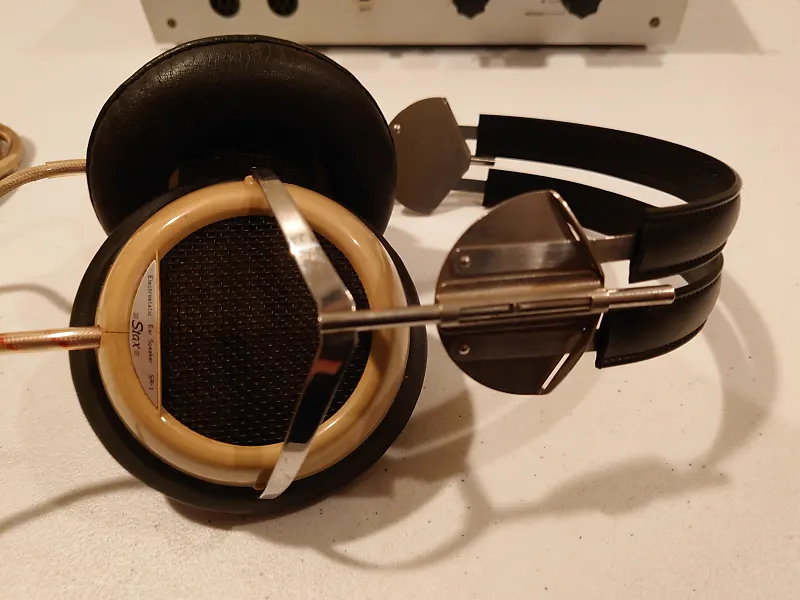
STAX has continued to make electrostatic headphones ever since, although they did experience a brief insolvency in 1995. Today, the company continues to produce superb headphones. Their latest flagship product is called the SR-X9000. Click here to visit the STAX Audio website.
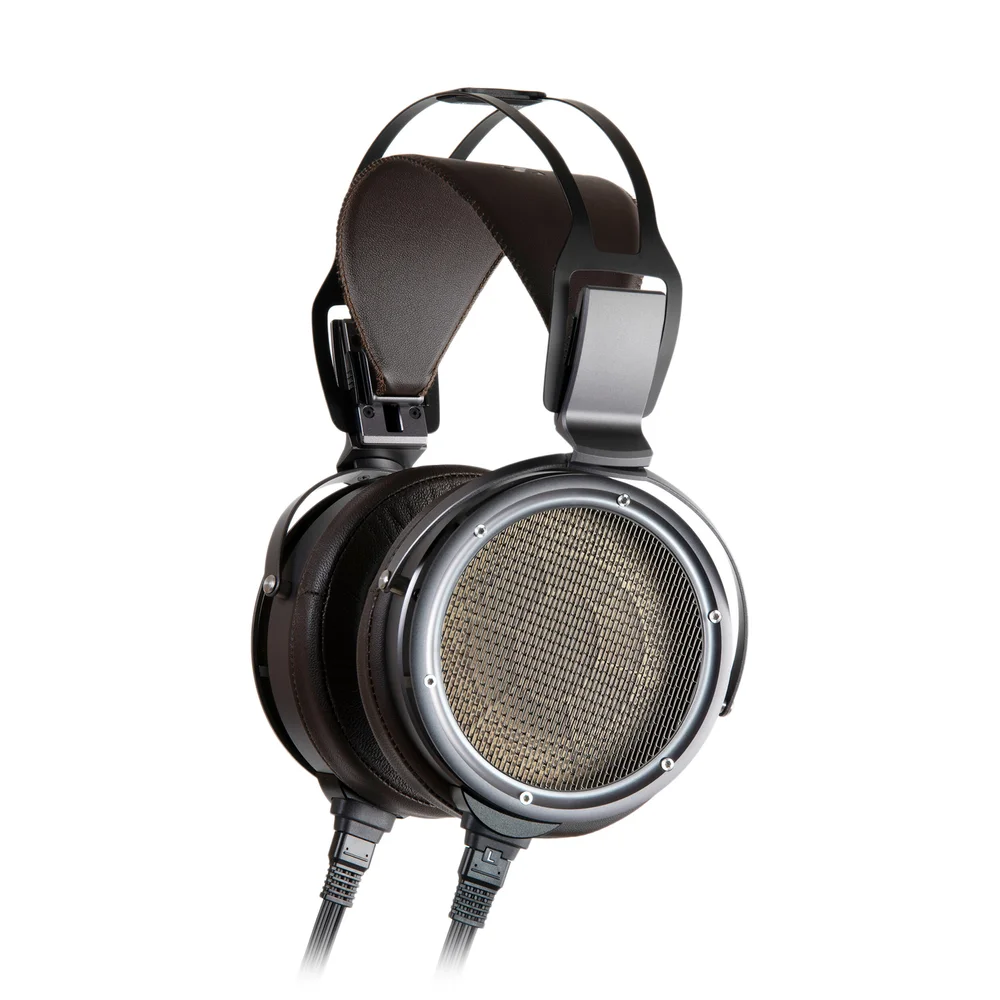
Koss
Our second entry is the American company Koss. The company’s founder, John Koss, introduced the world’s very first stereo headphones, the model SP/3, way back in 1958. The Koss SP/3 was inducted into the Hi-Fi Hall of Fame in 2024; please click here to see our profile of the SP/3.
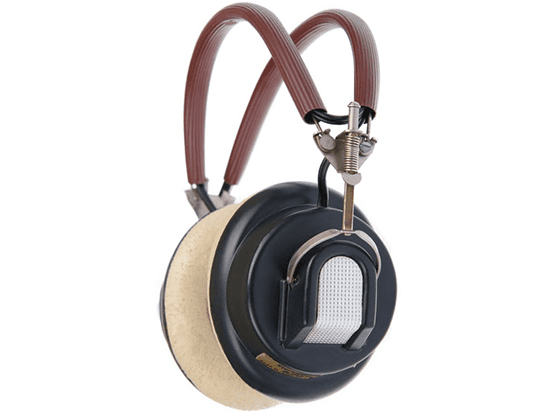
Koss headphones were very popular and the company developed a wide range of best selling products using dynamic drivers. Koss produced their first electrostatic model, the ESP/6, around 1968.
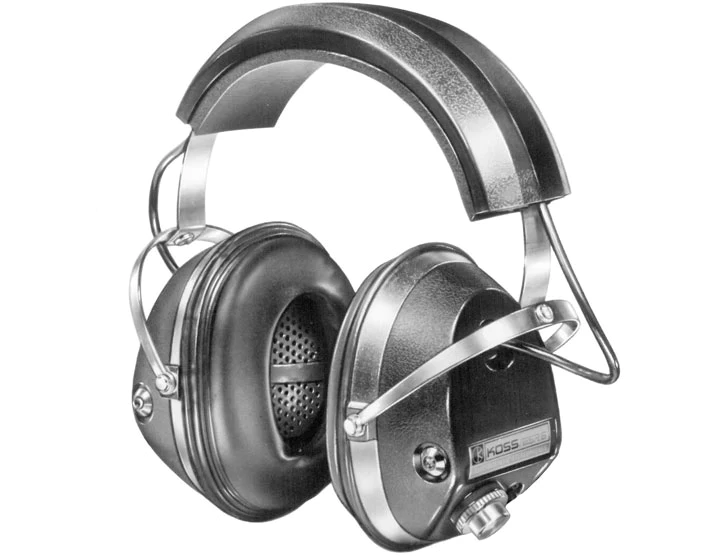
Koss is still making electrostatic headphones today; their latest model is the ESP/950. Click here to visit the Koss website.
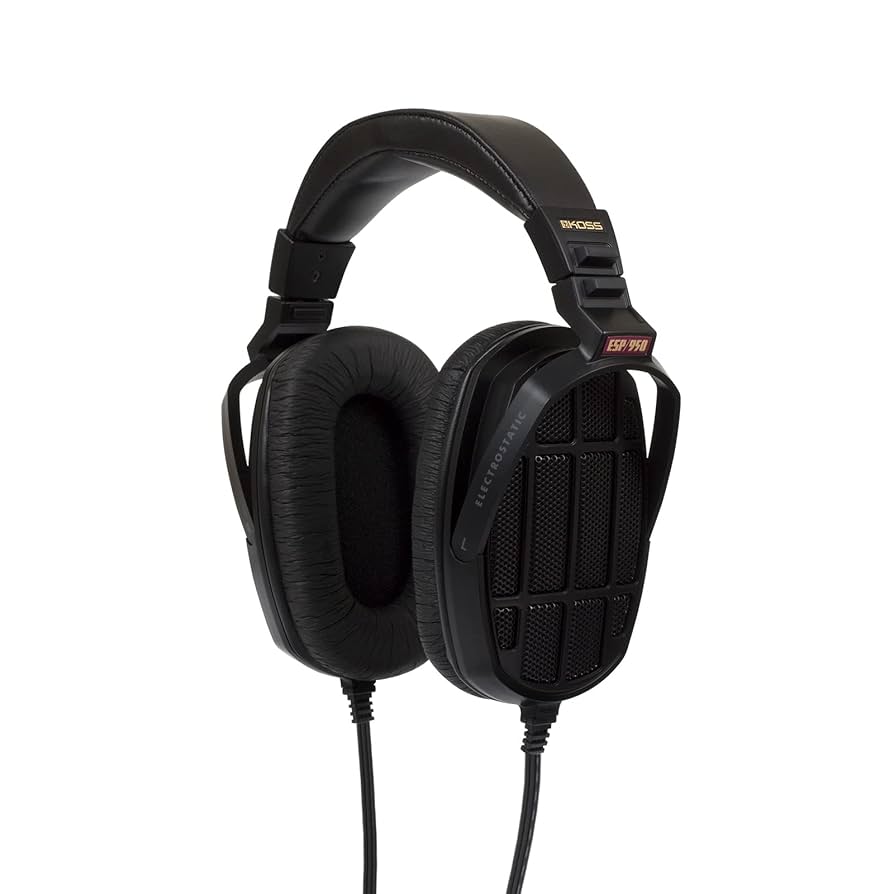
Sennheiser
Last but not least, Sennheiser is one of Europe’s top headphone manufacturers. Sennheiser started making headphones in the 1950s but began making headlines in the consumer market in 1968 with the release of the HD 414, a superb dynamic headphone employing an open back design.
Sennheiser released their first electrostatic, the “Unipolar 2000”, in 1977. It was a pioneering design that achieved a “world’s first” distinction: it was the world’s first open back electrostatic headphone.
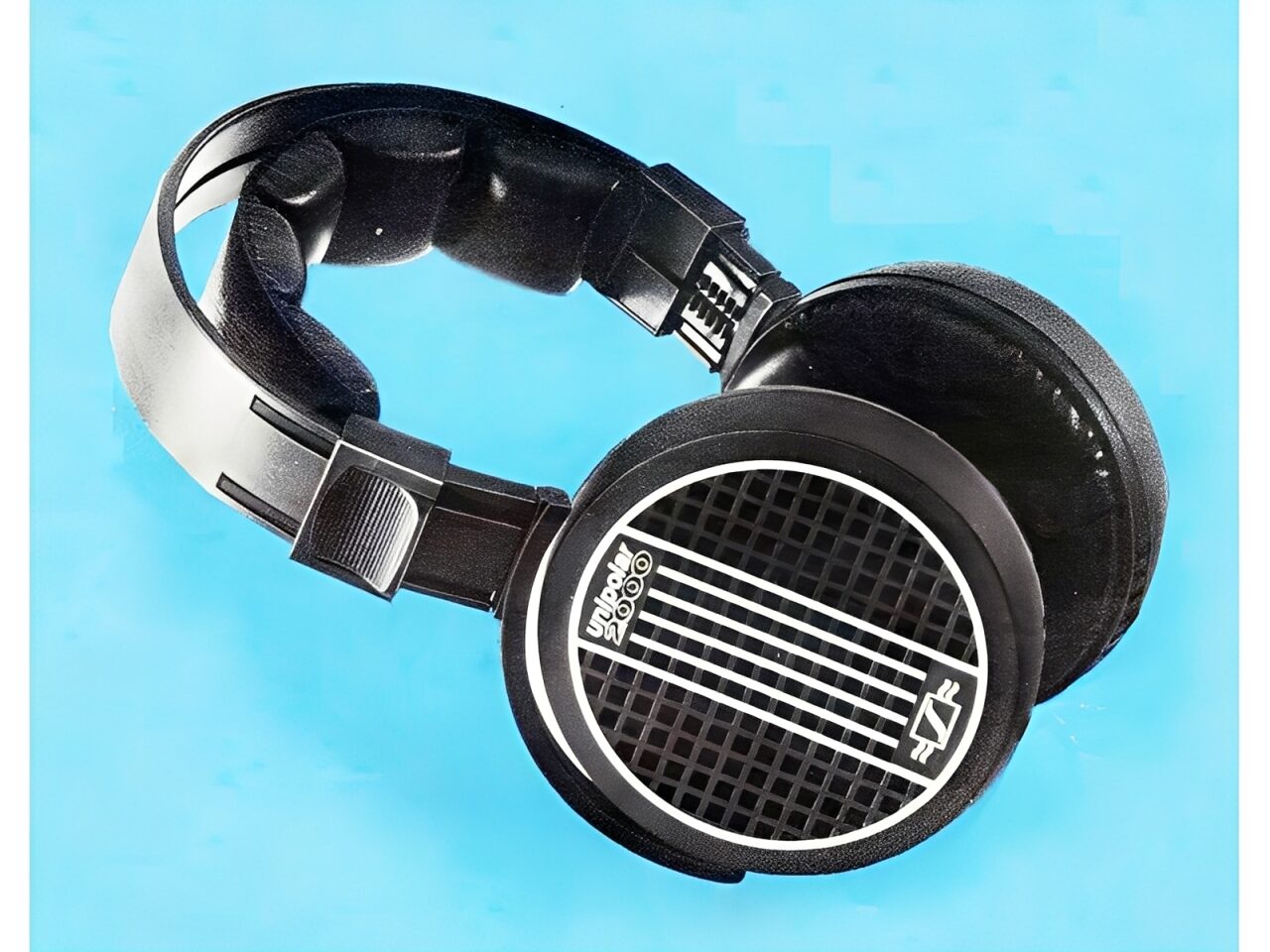
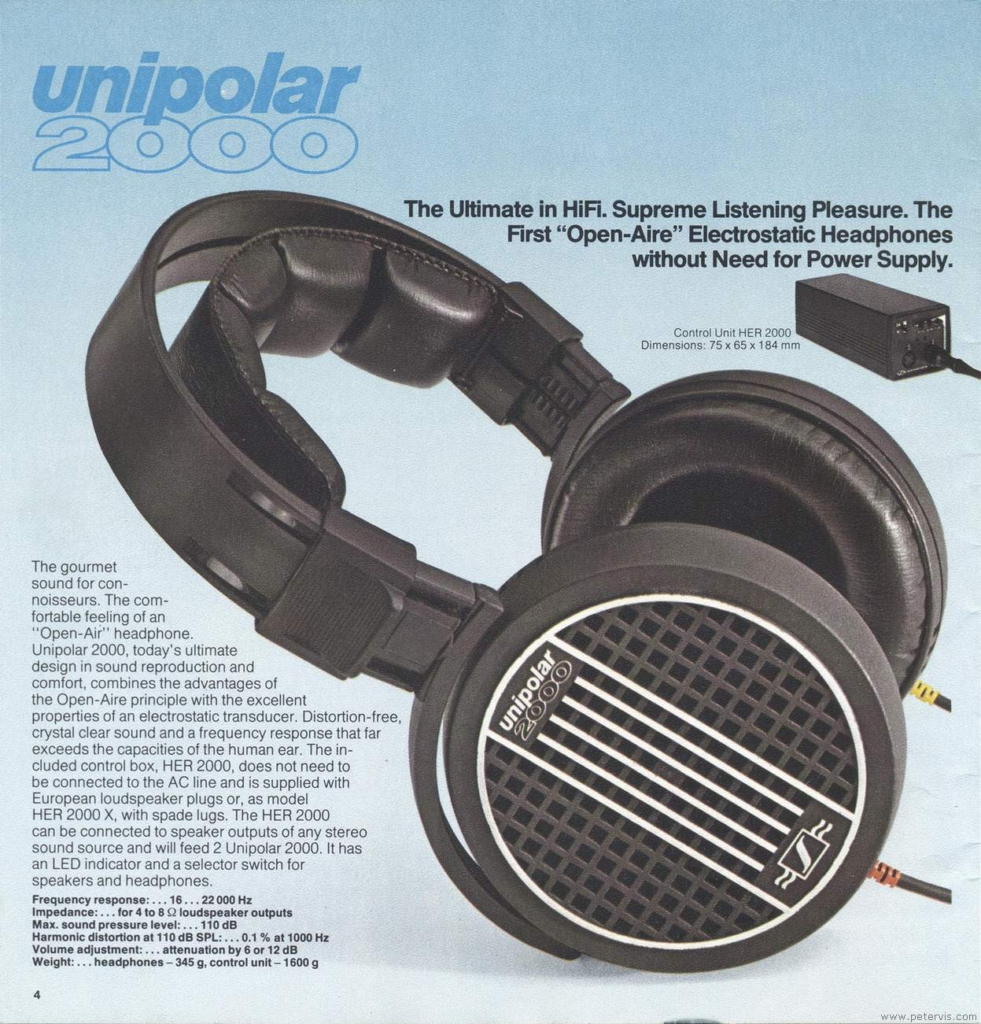
Since then, Sennheiser has produced two noteworthy flagship electrostatics: the Orpheus HE 90 (in 1991) and the more recent HE-1.
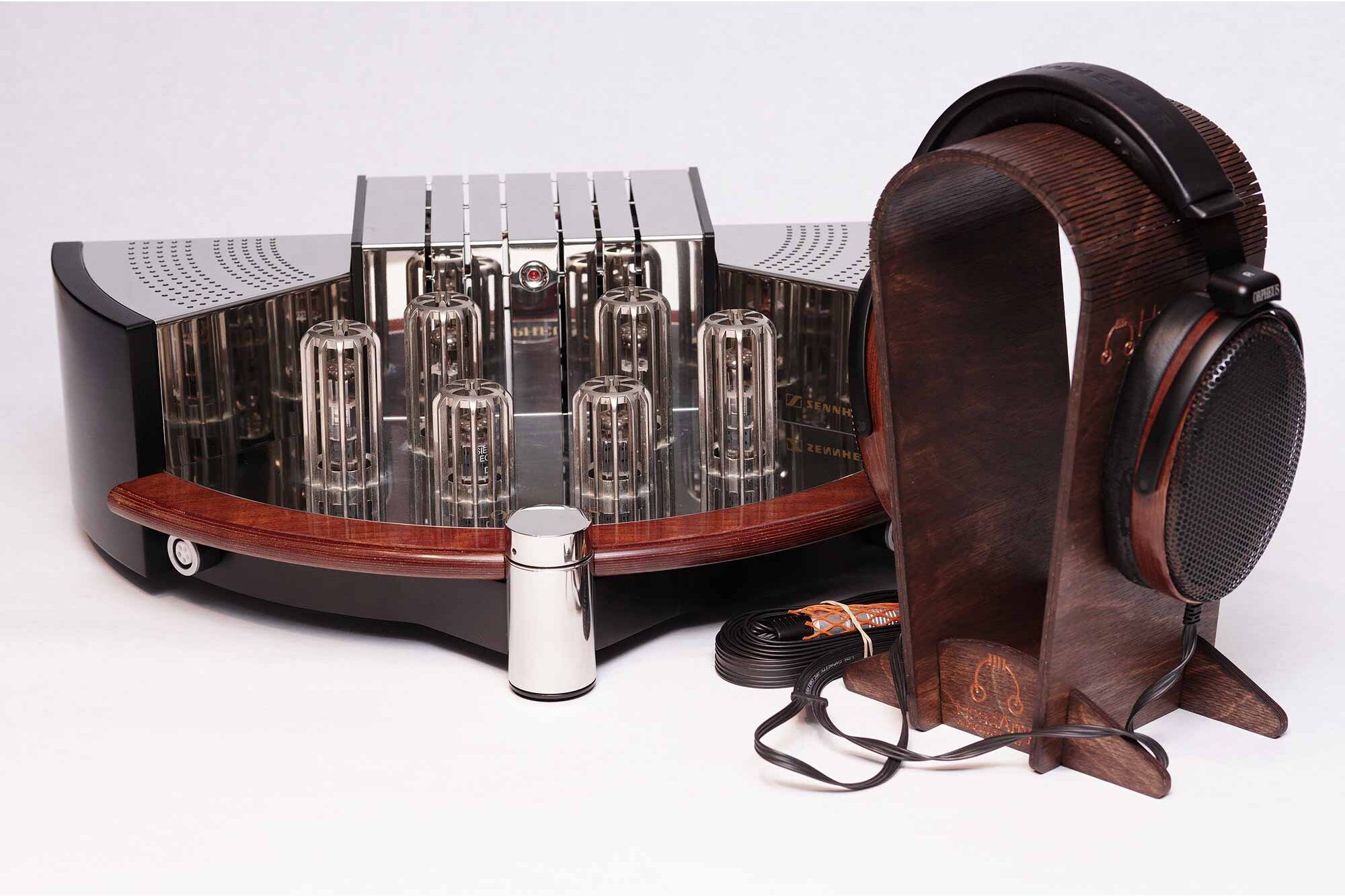
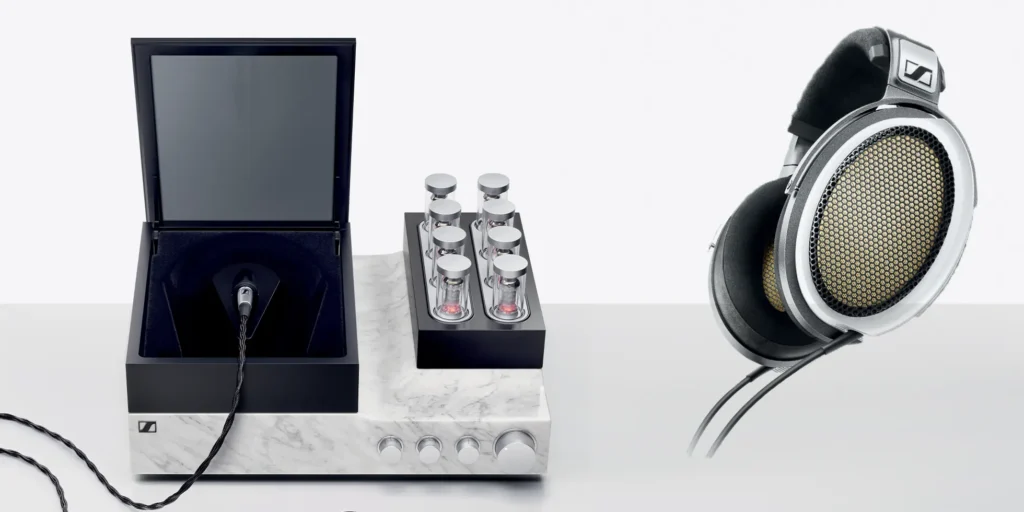
Click here to visit the Sennheiser website showing their broad range of headphones, microphones, and associated audio equipment. There is also a Sennheiser shop website where Hi-Fi equipment is sold, and here is a direct link to the fabulous HE-1.
Electrostatic Loudspeaker Technology: Induction into the Hi-Fi Hall of Fame
Does electrostatic loudspeaker technology belong in the Hi-Fi Hall of Fame?
After more than 70 years, electrostatic loudspeakers remain a niche technology — admired by a devoted few, but never achieving mass-market dominance. Dynamic cone speakers have long ruled the living room, leaving electrostatics as the choice of the curious, the passionate, and the uncompromising.
But the Hall of Fame doesn’t measure worth by sales figures. Many of the technologies that define high-fidelity audio — moving-coil cartridges, ribbon tweeters, Air Motion Transformers — have always been rare. What they share is not popularity, but influence.
Electrostatics embody the Hi-Fi spirit: a relentless pursuit of purity, innovation, and the illusion of live sound. From the Quad ESL-57 to the MartinLogan Neolith, these transparent panels redefined what “accuracy” could mean. They challenged designers, inspired listeners, and shaped decades of audio thinking.
Hi-Fi thrives on new approaches — and few have been as big, bold, beautiful, or enduring as the electrostatic loudspeaker.
For all of these reasons, electrostatic loudspeaker technology is inducted into the Hi-Fi Hall of Fame.
